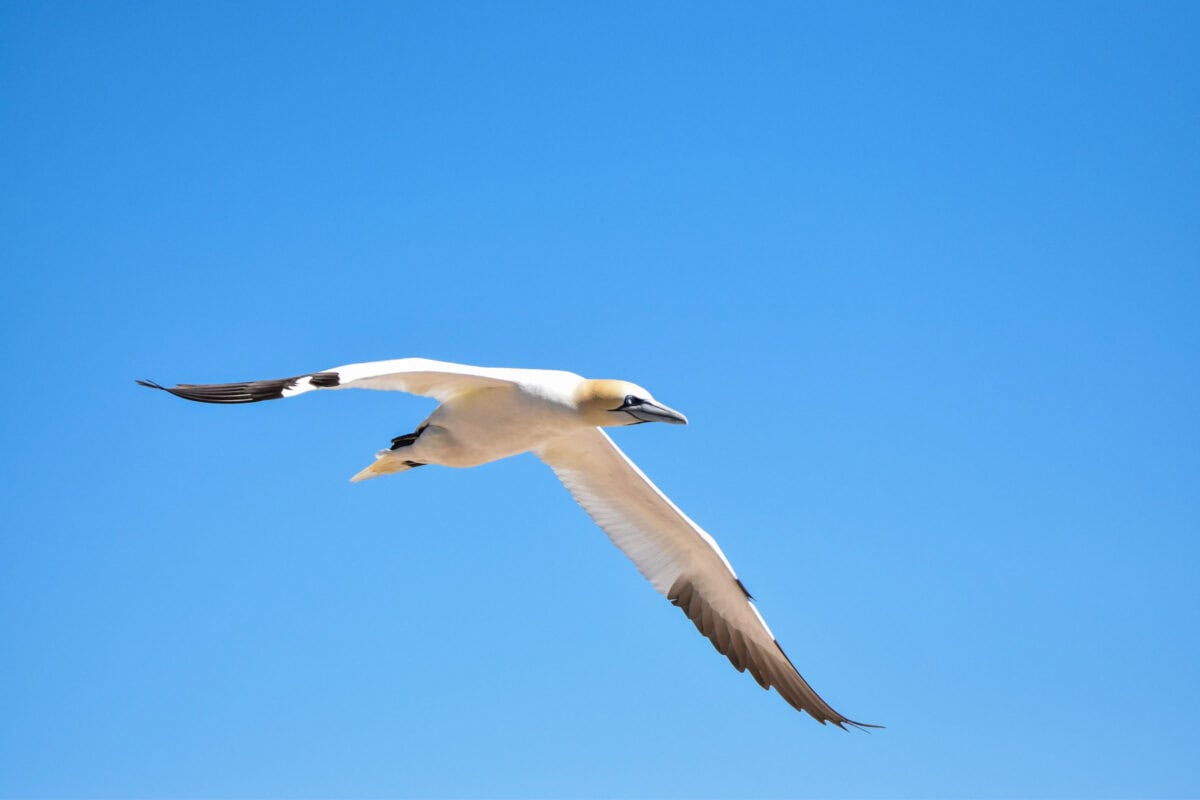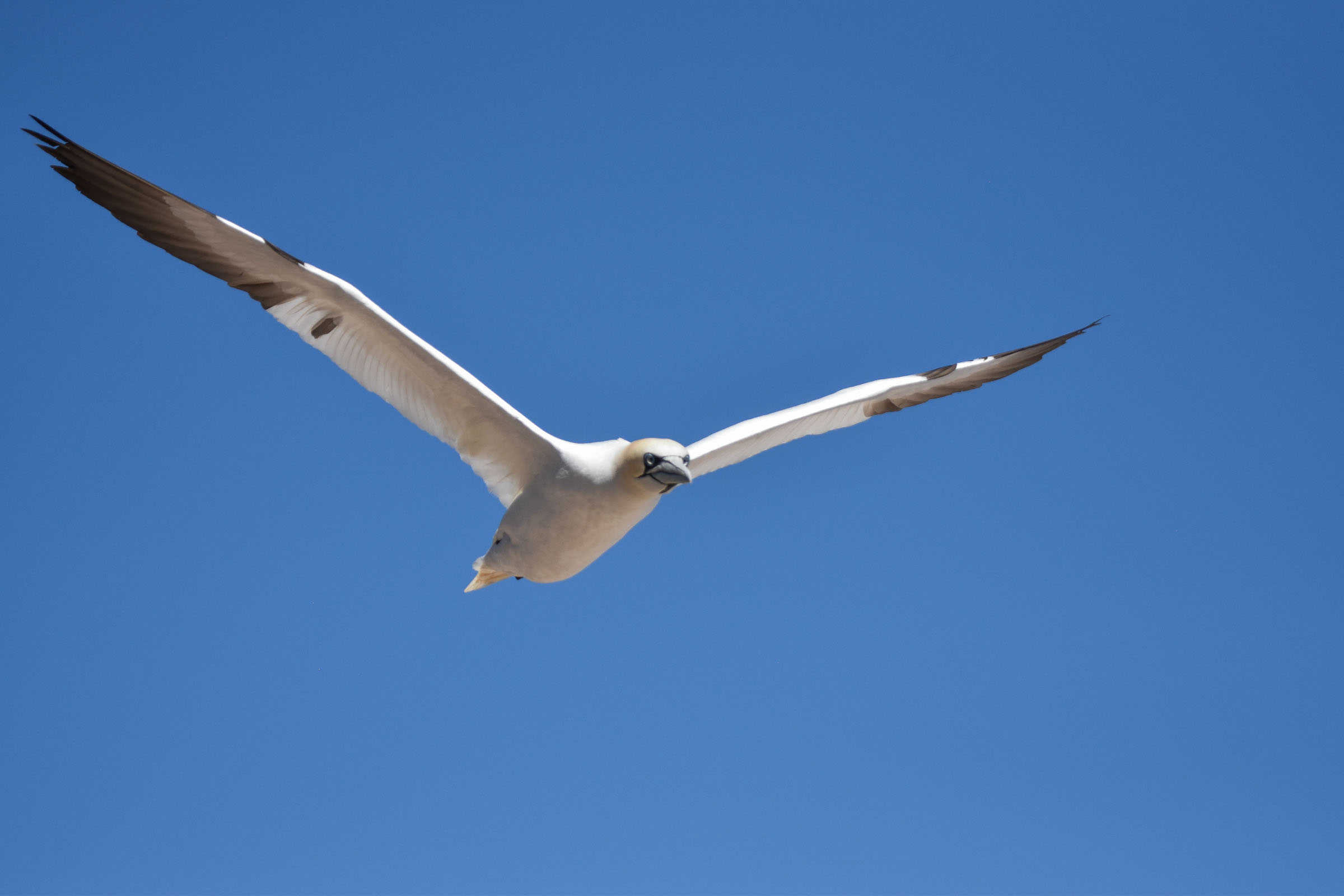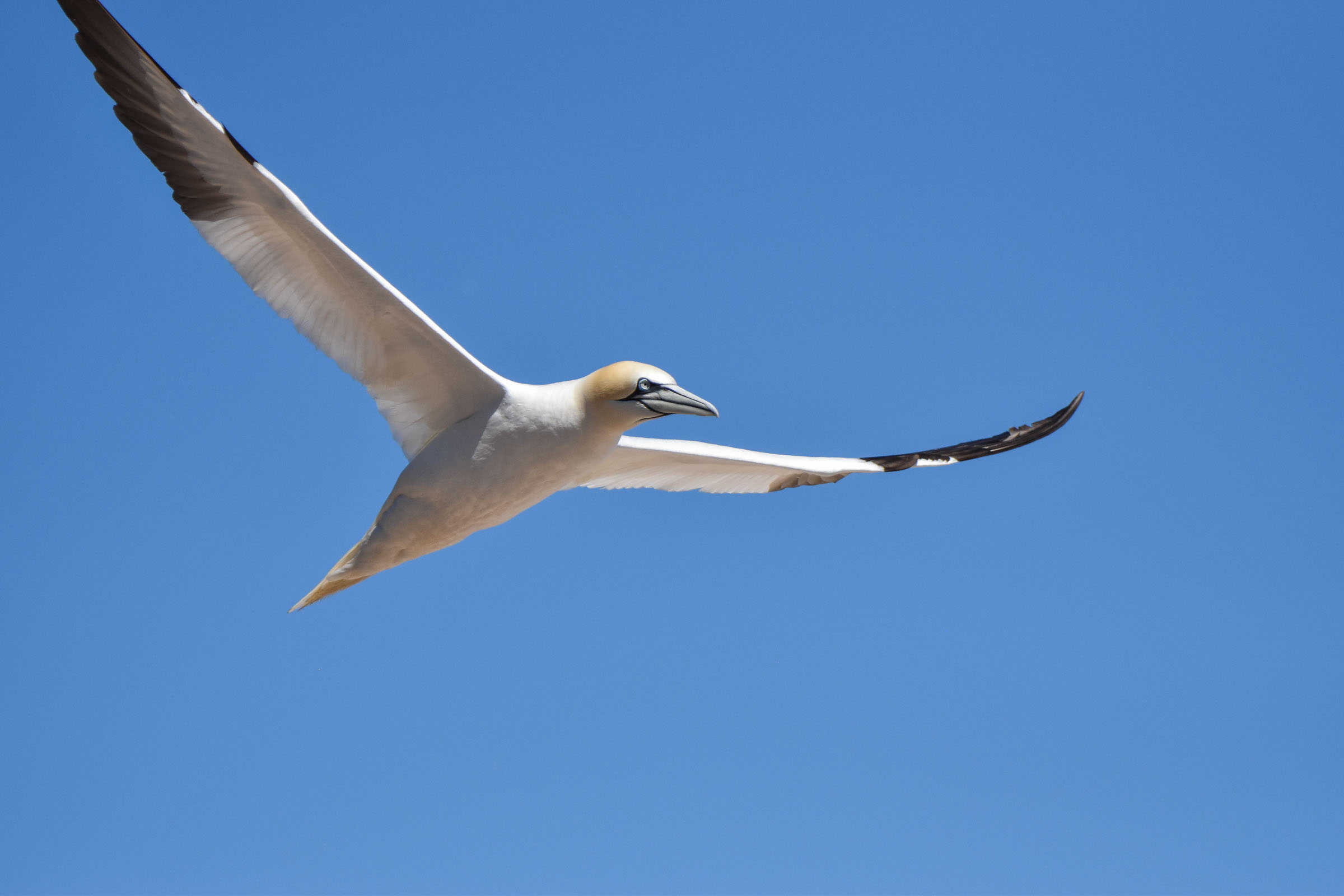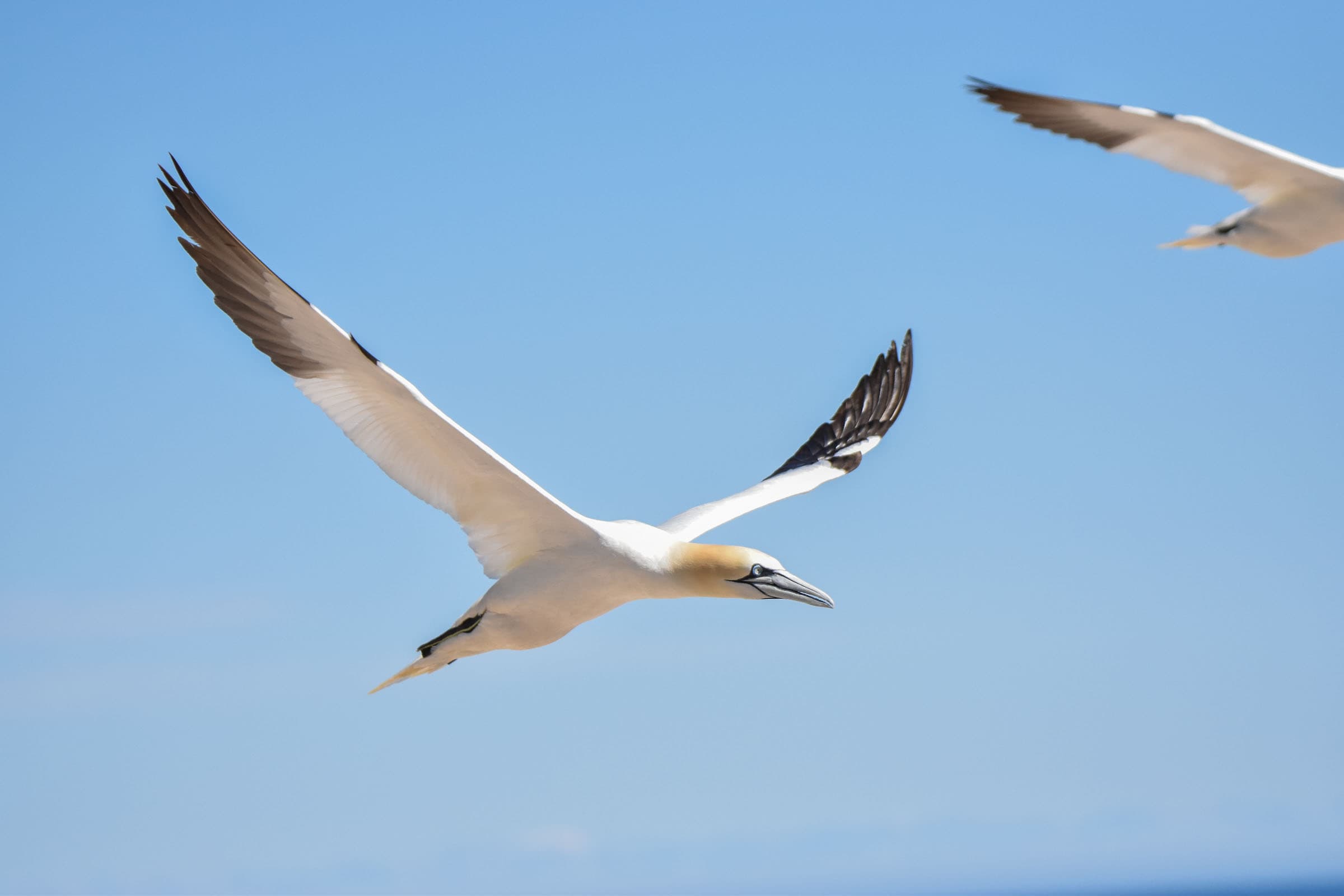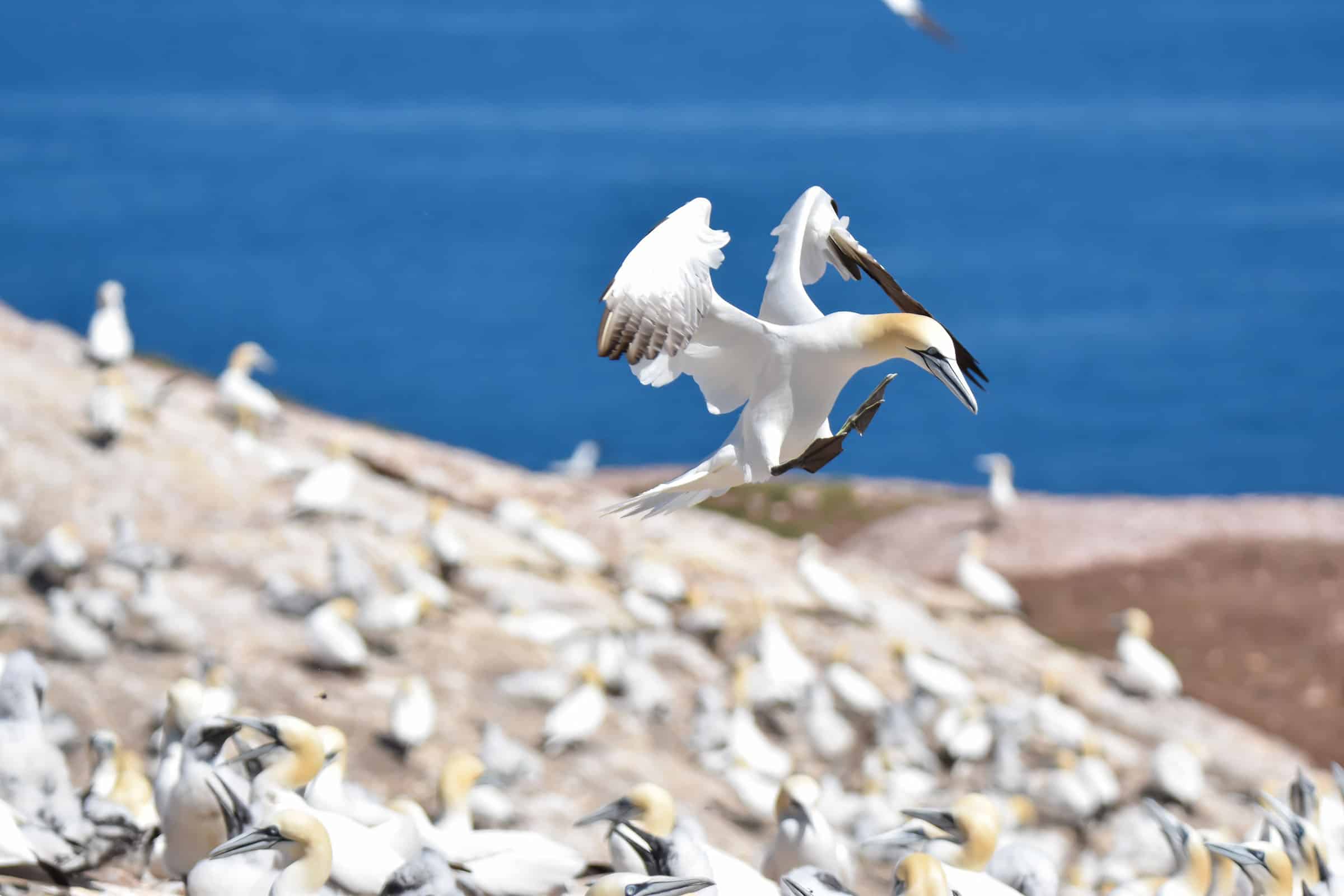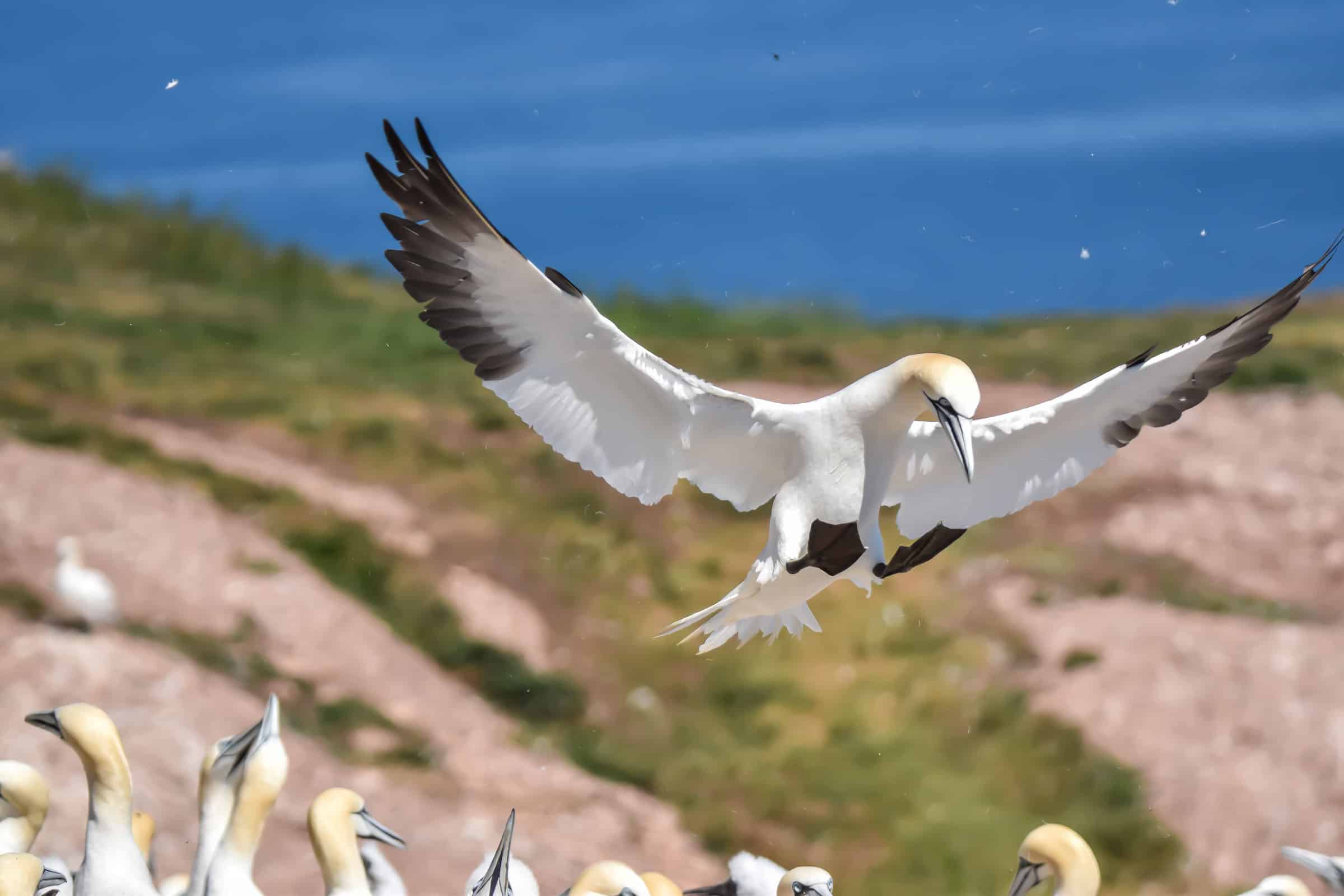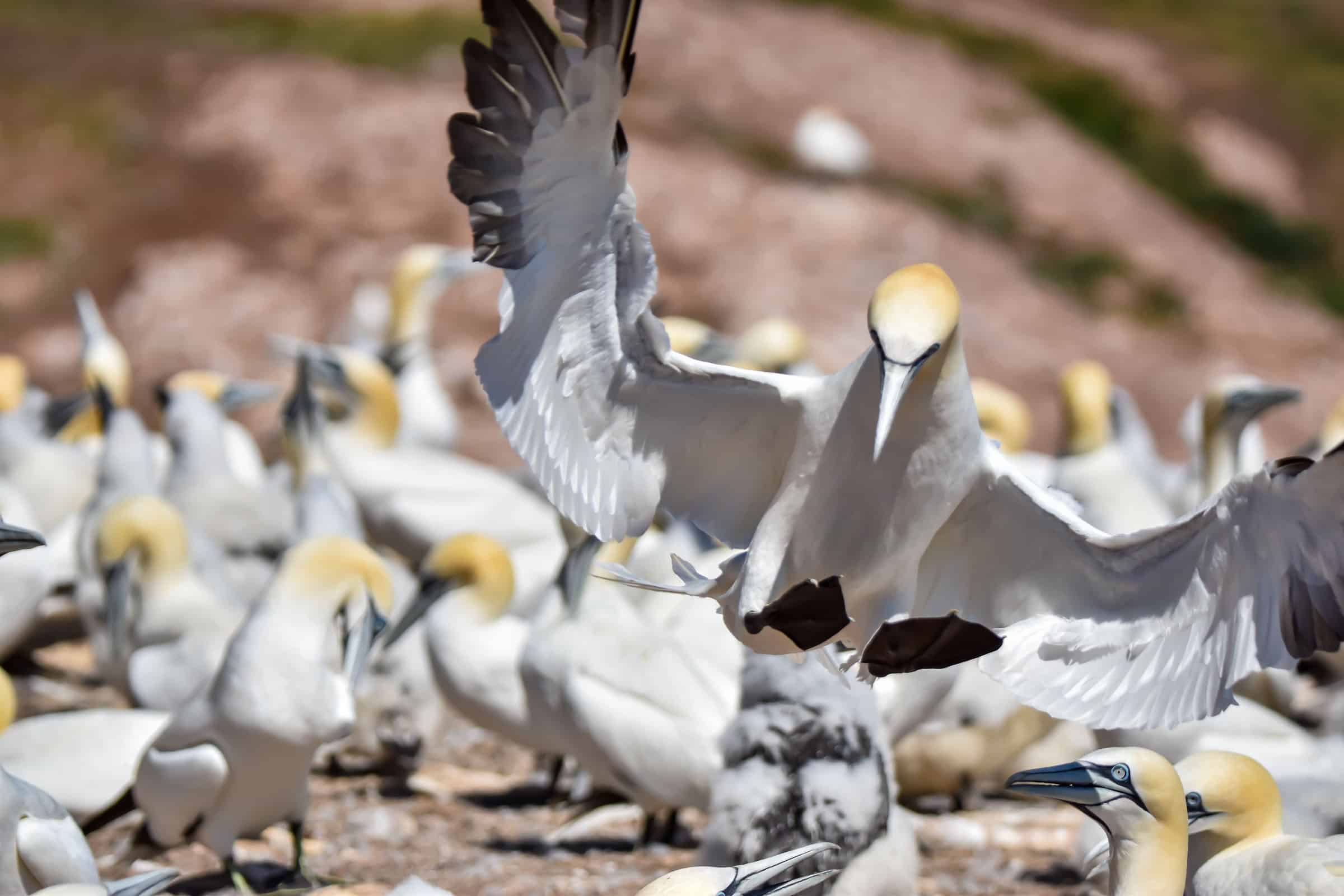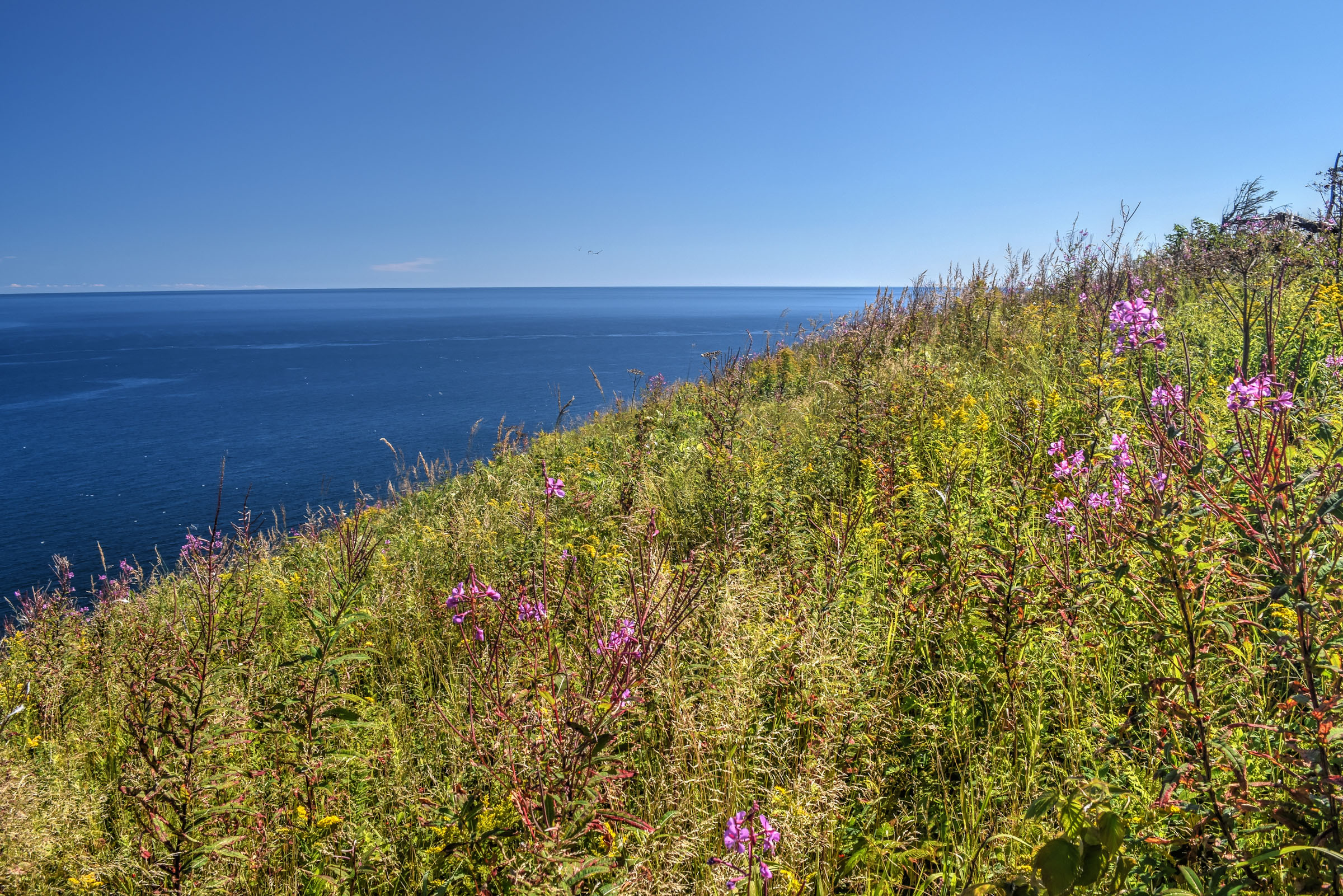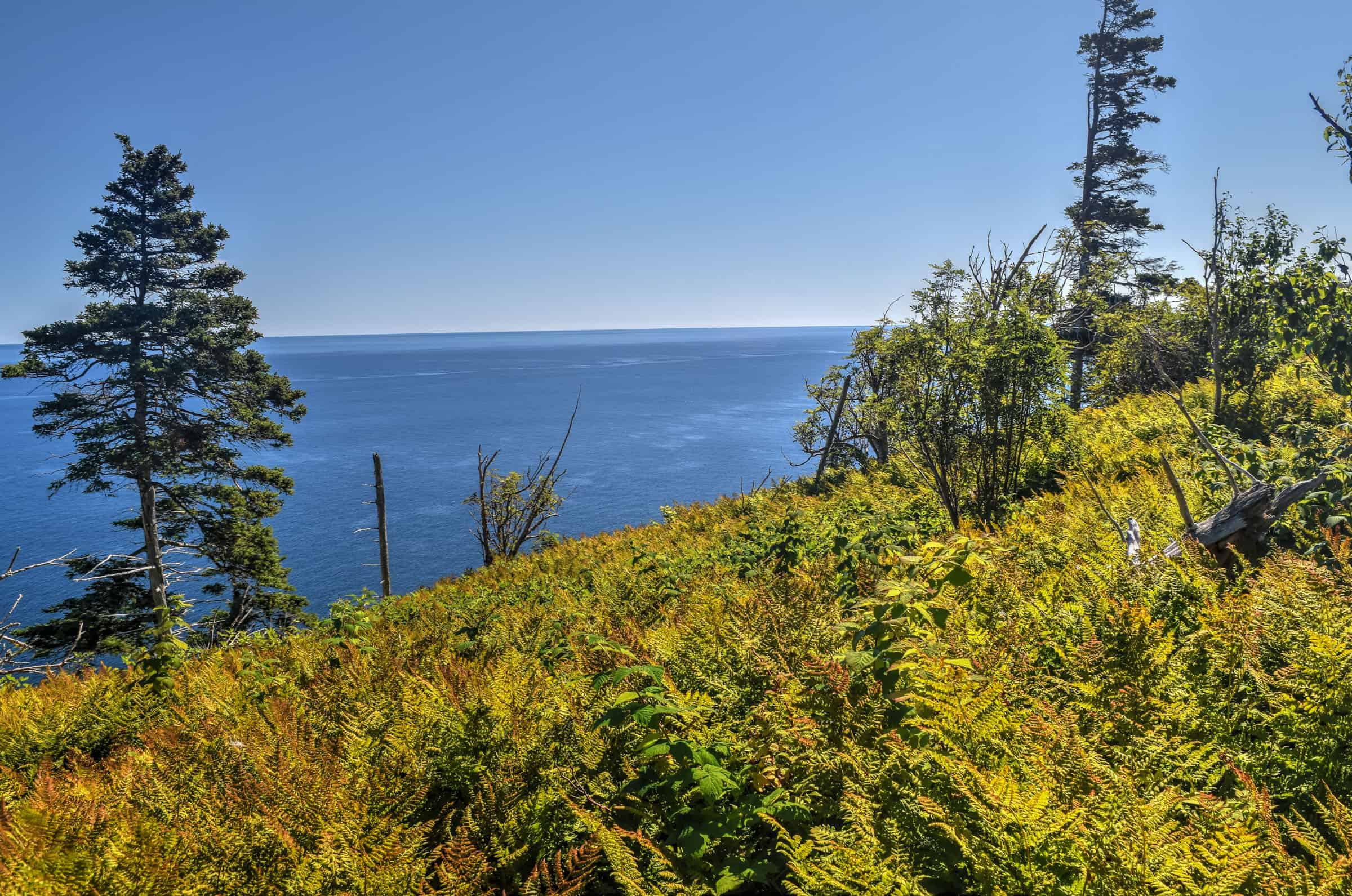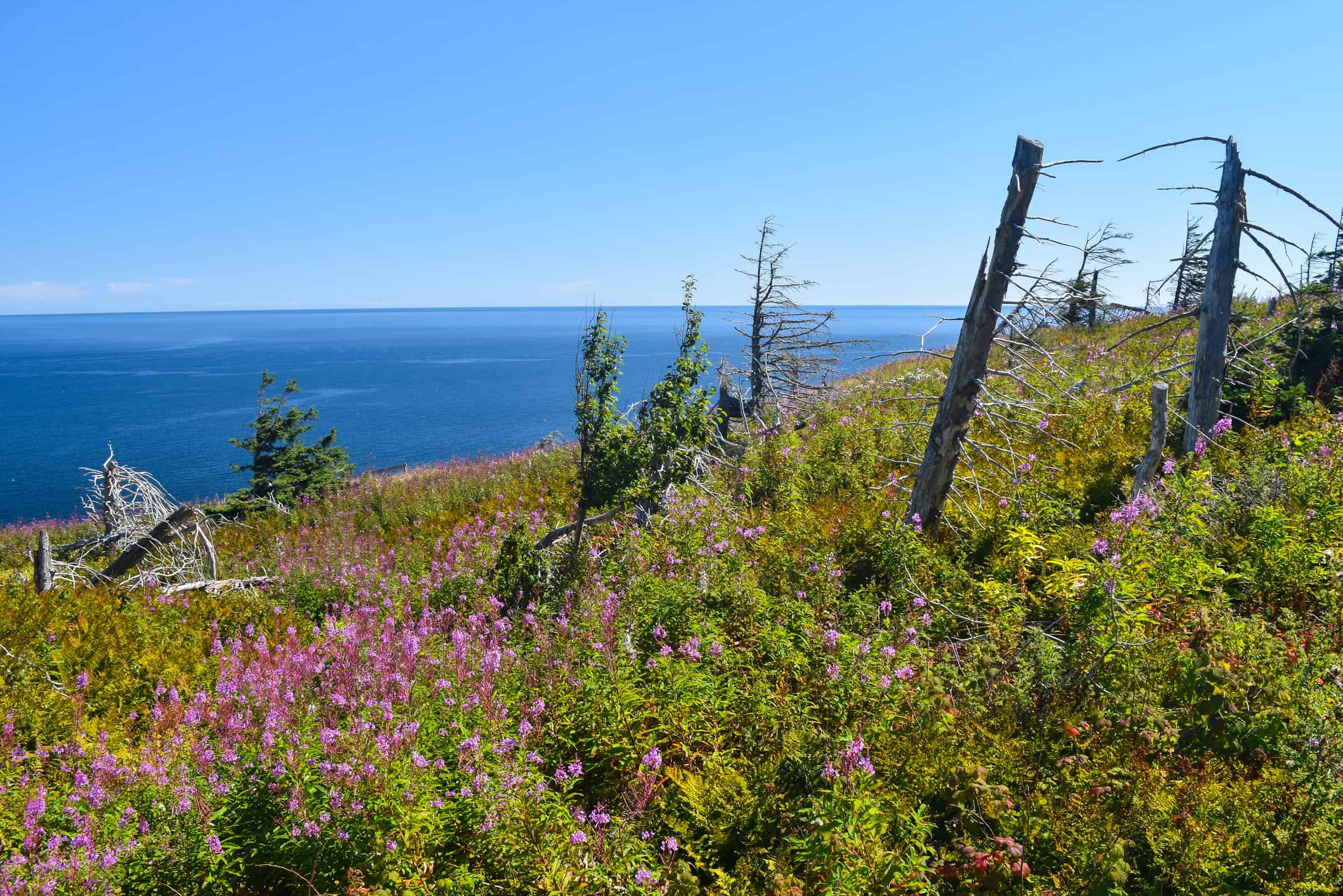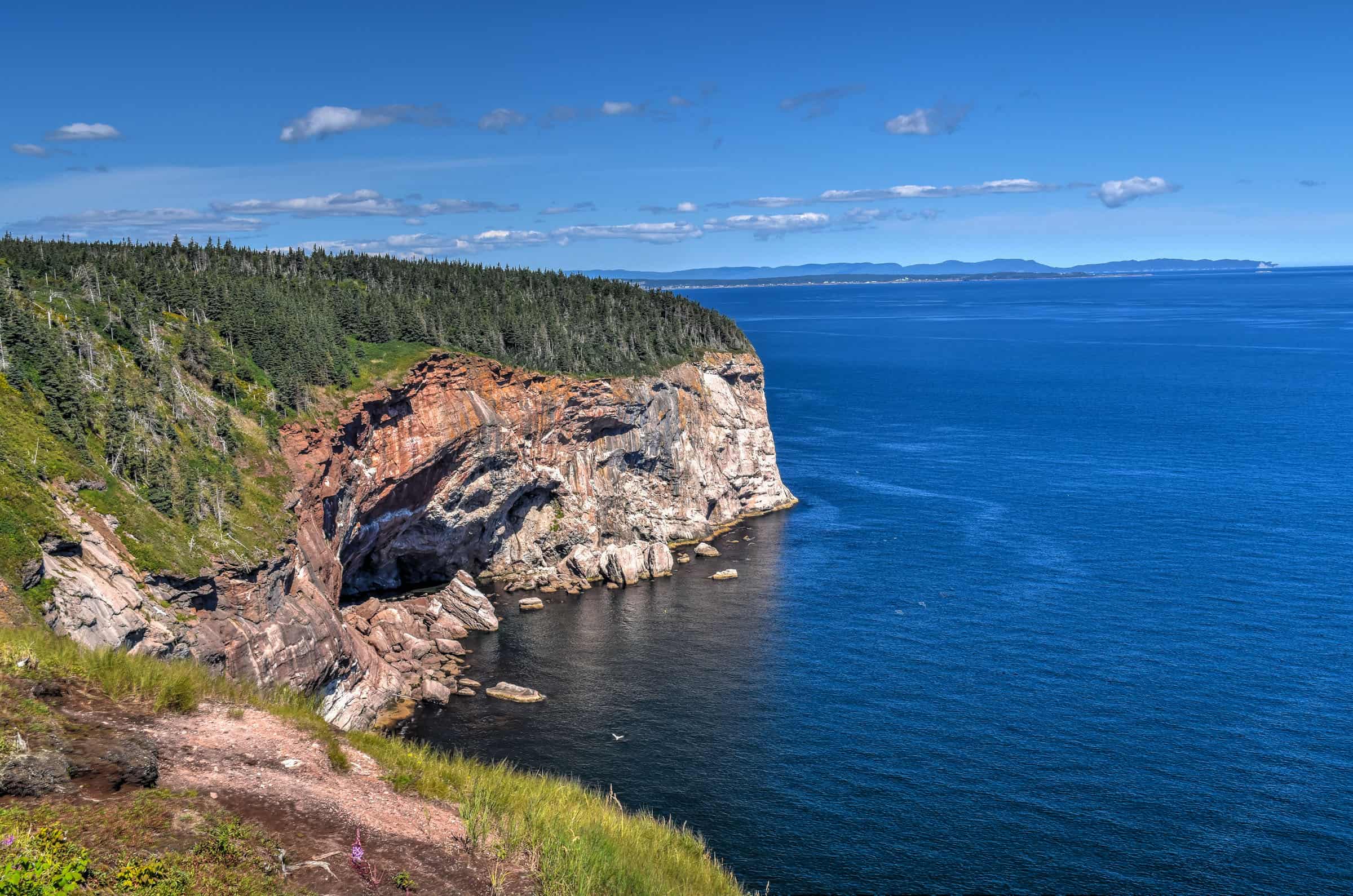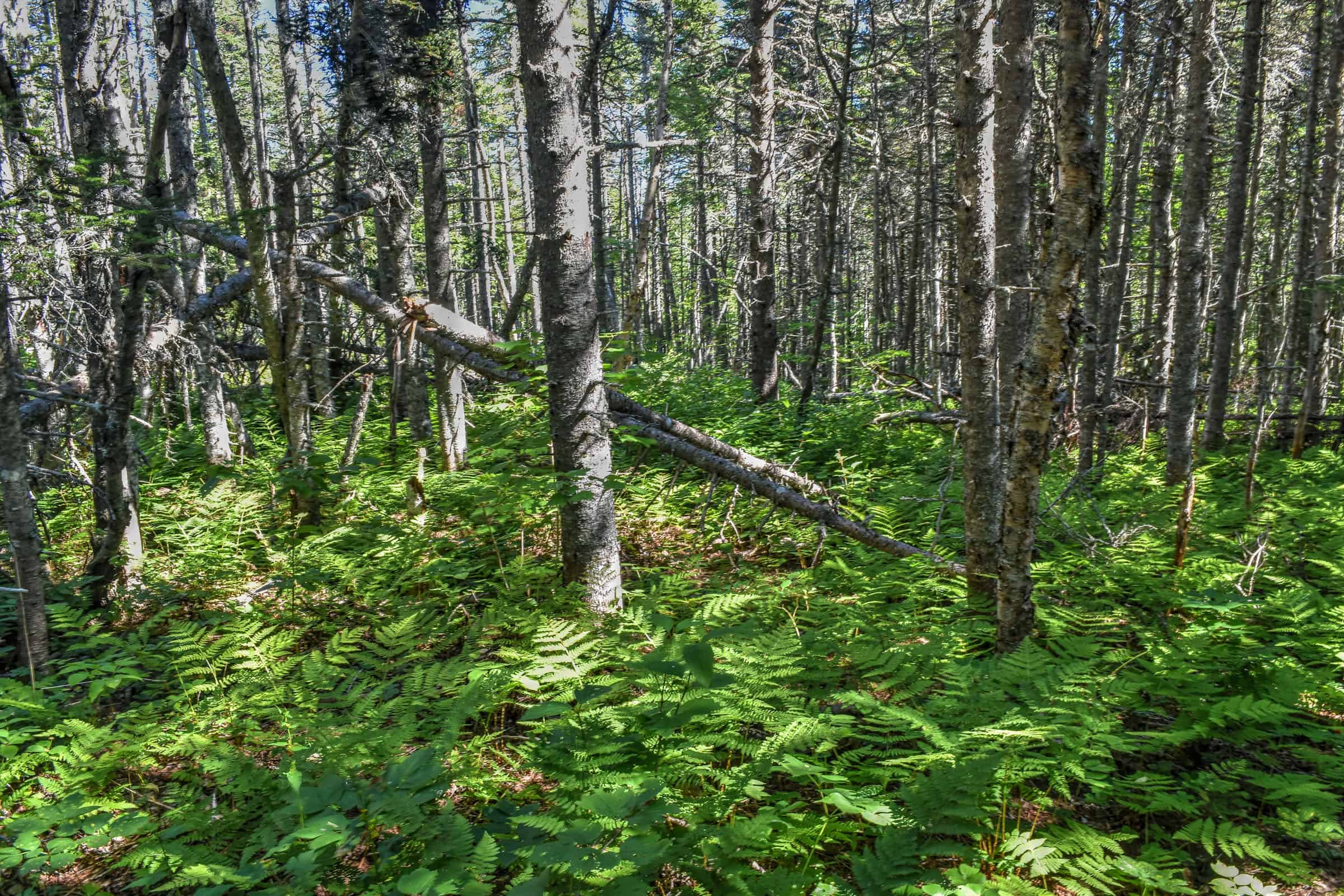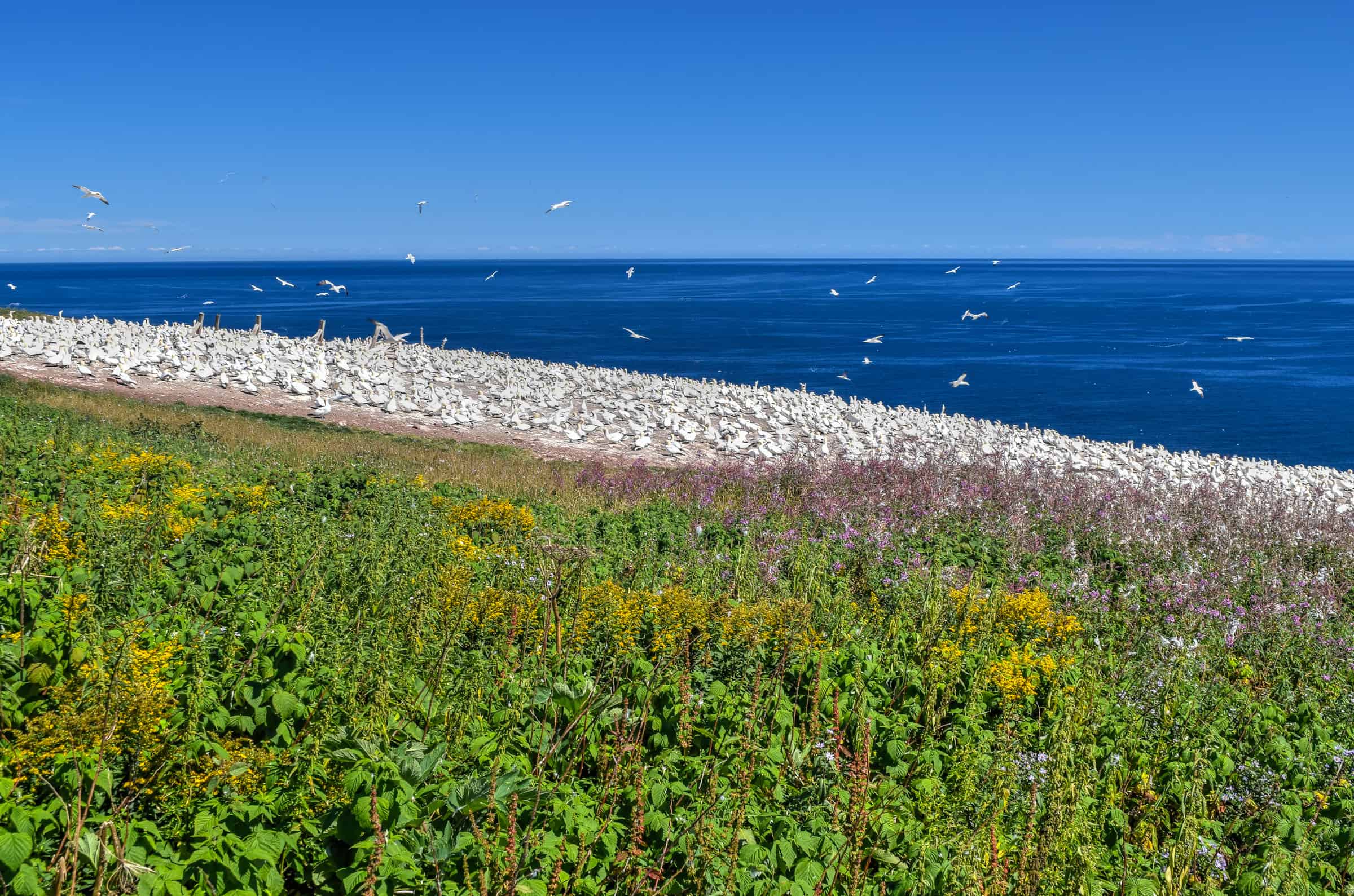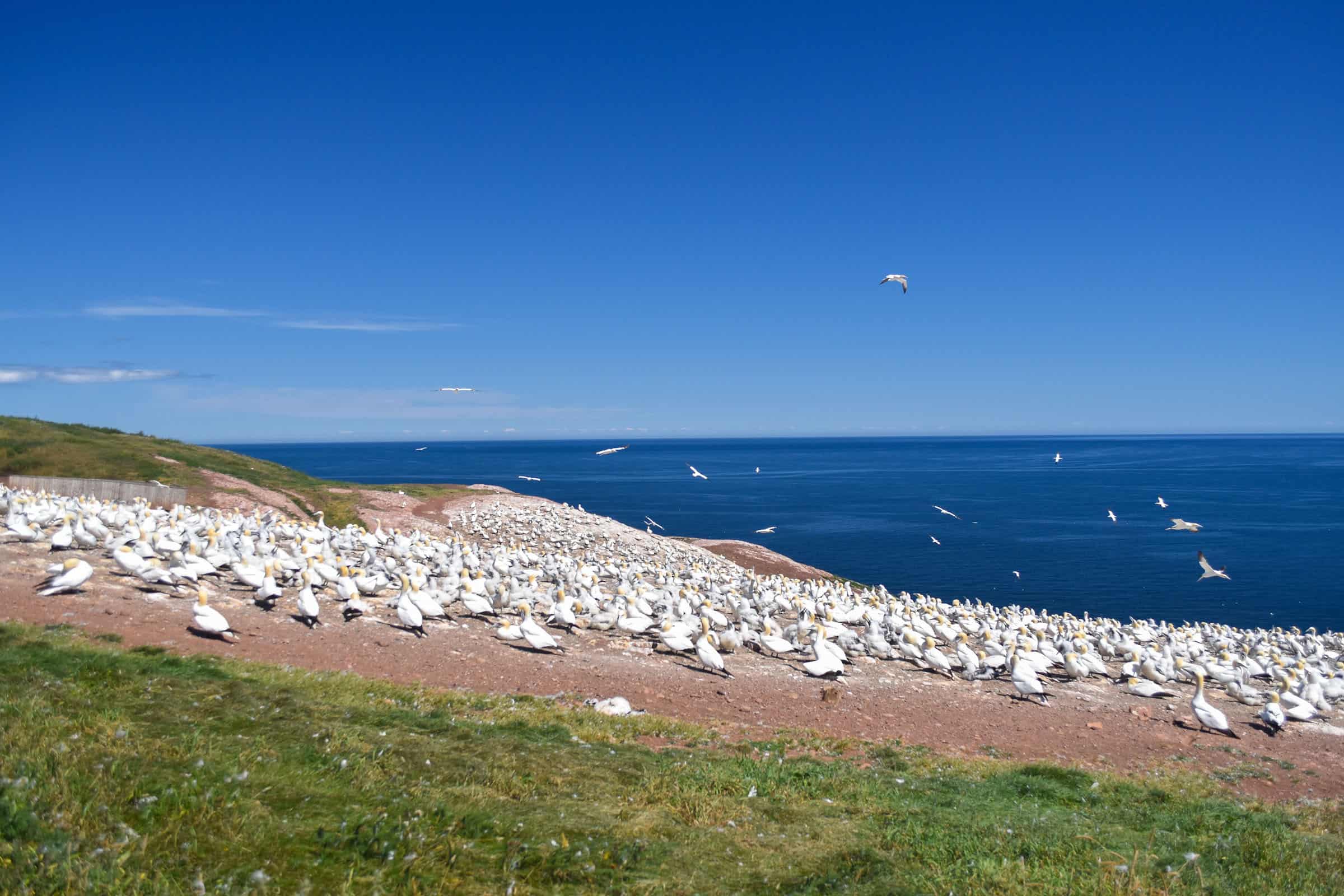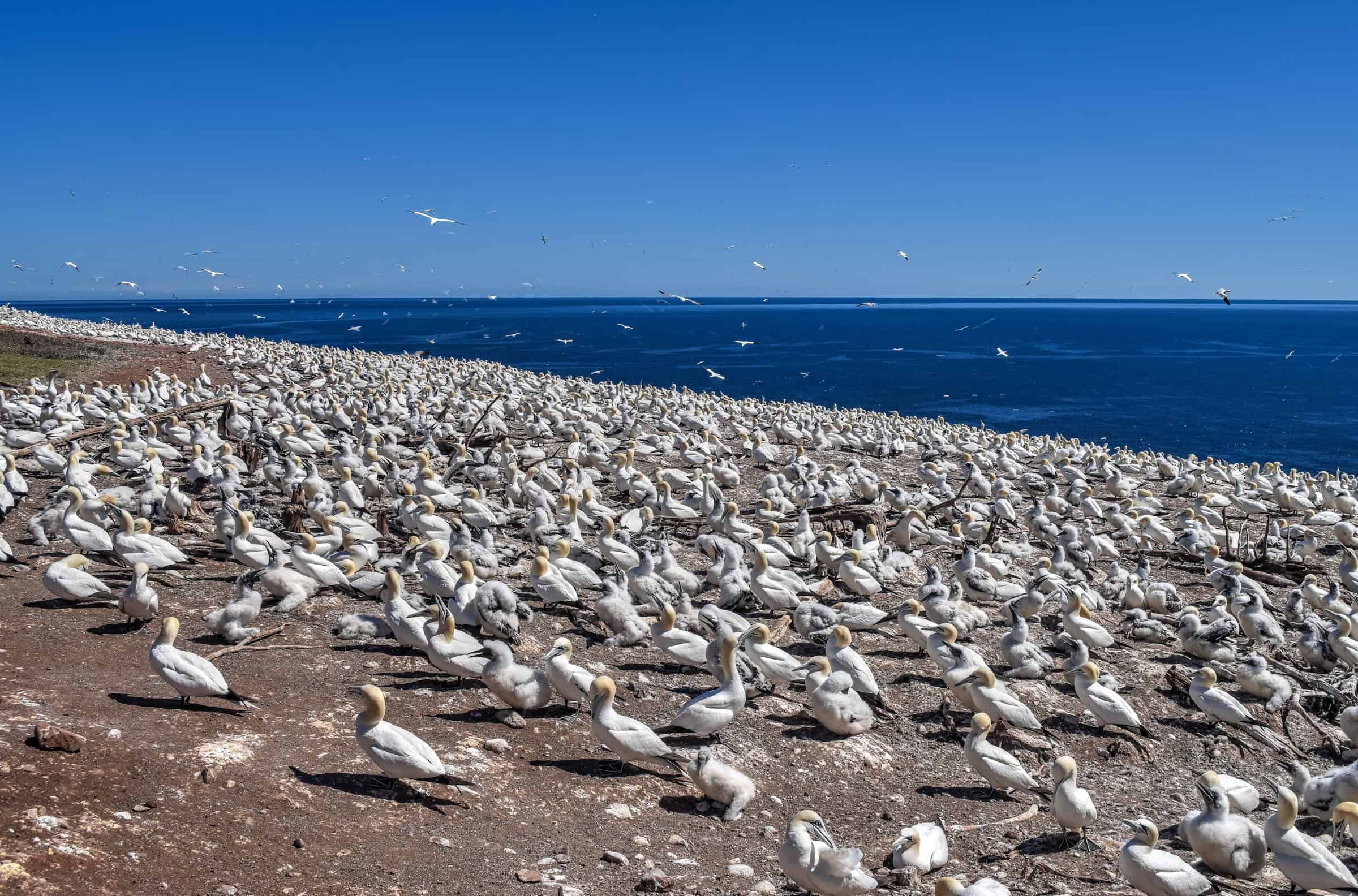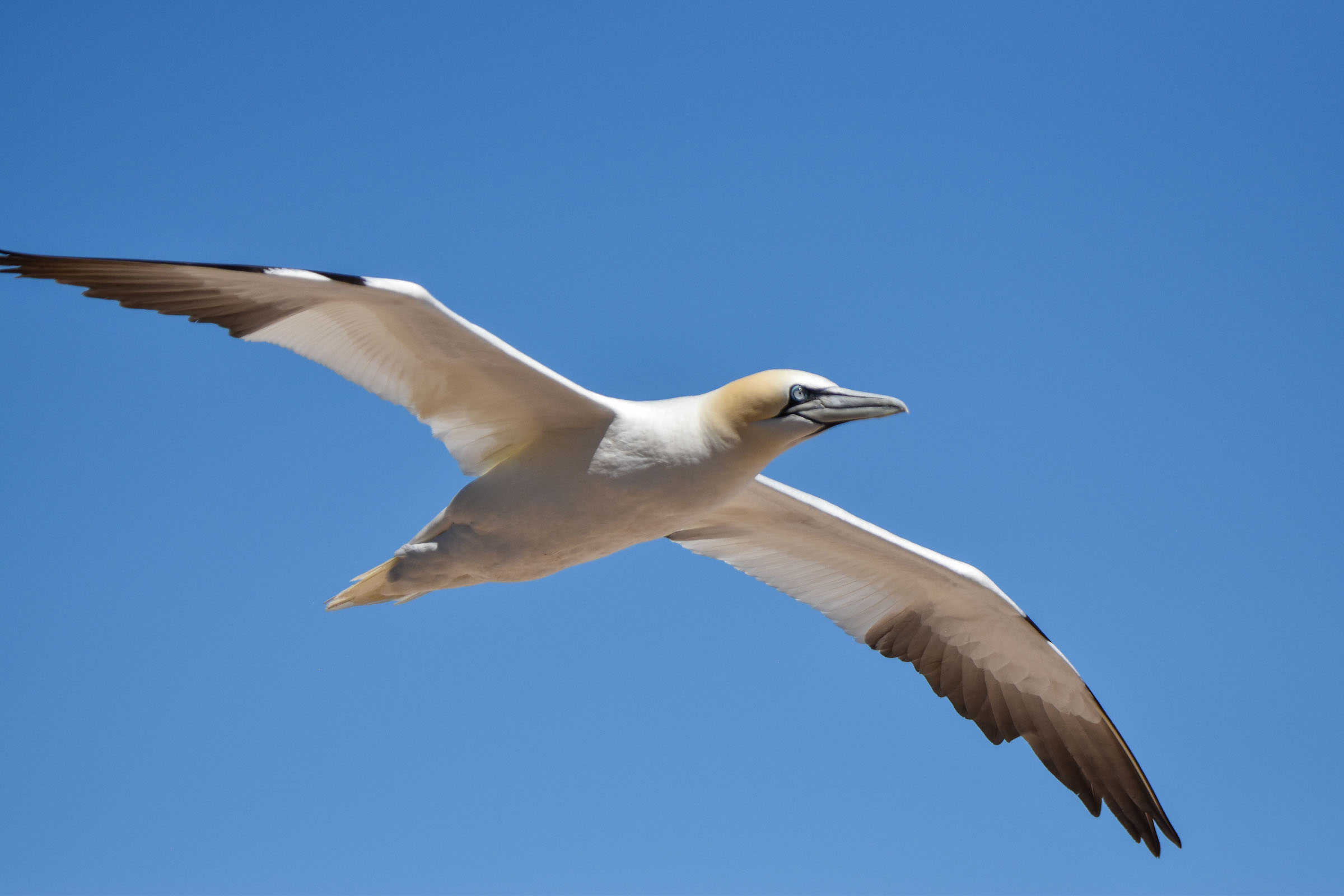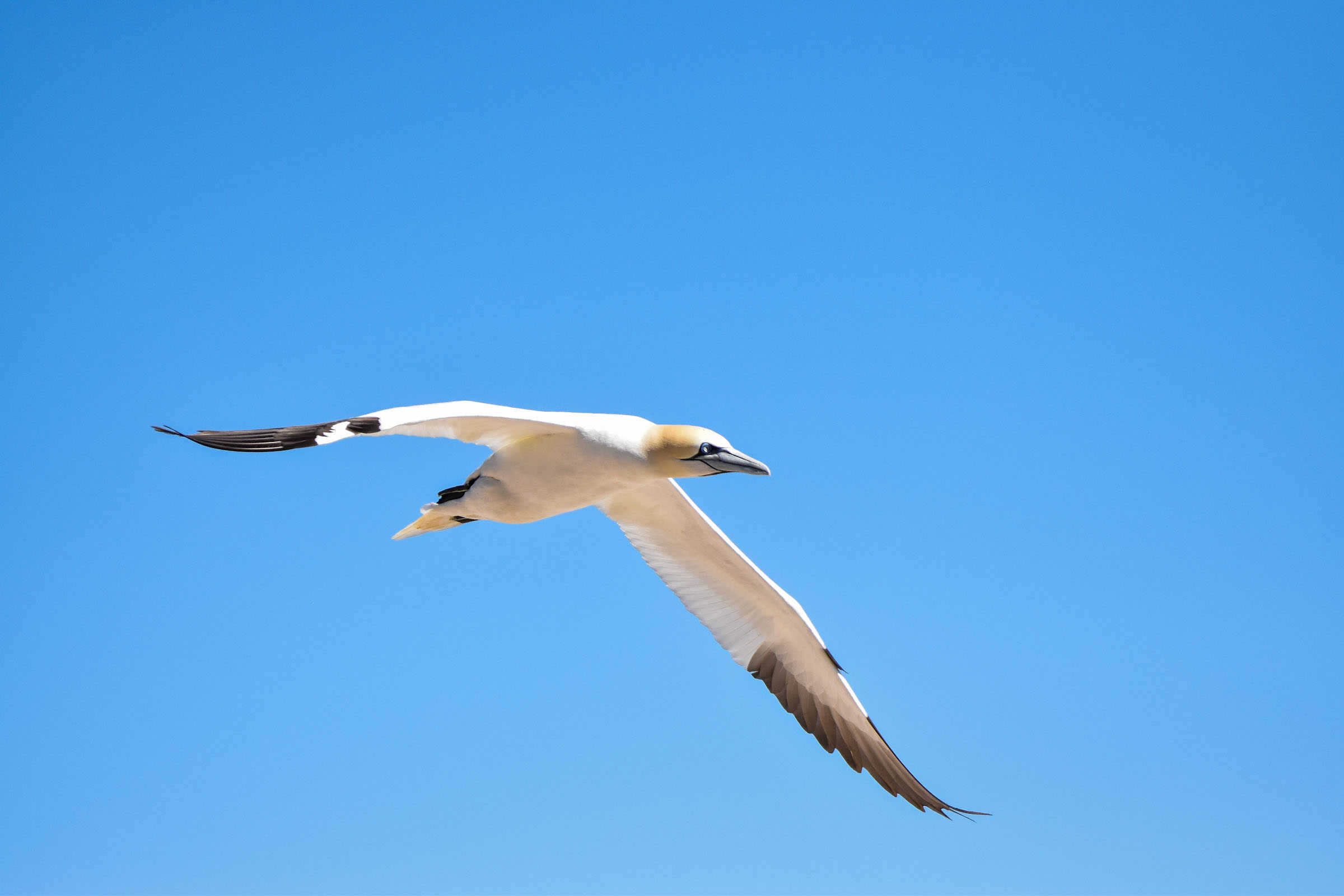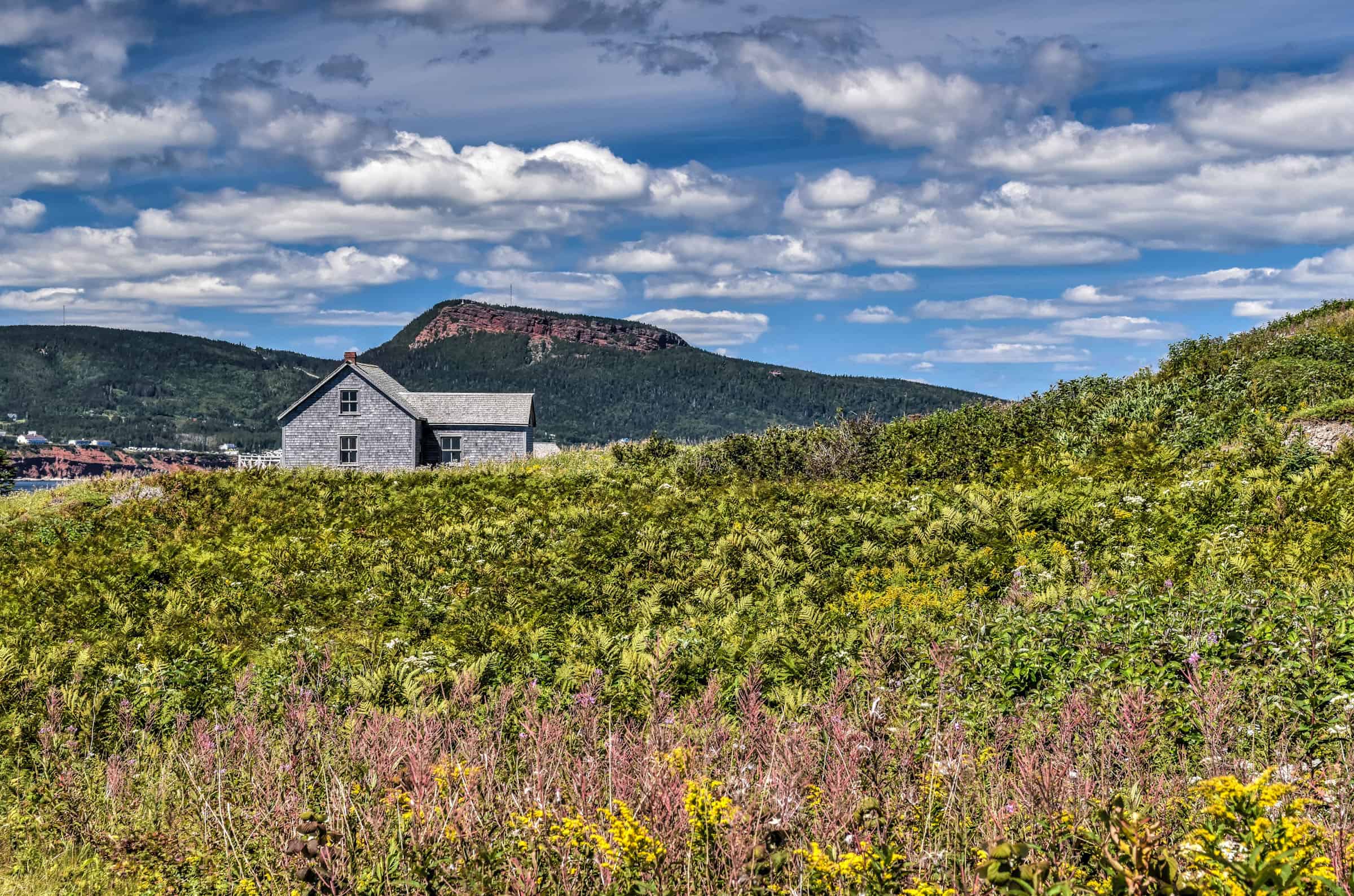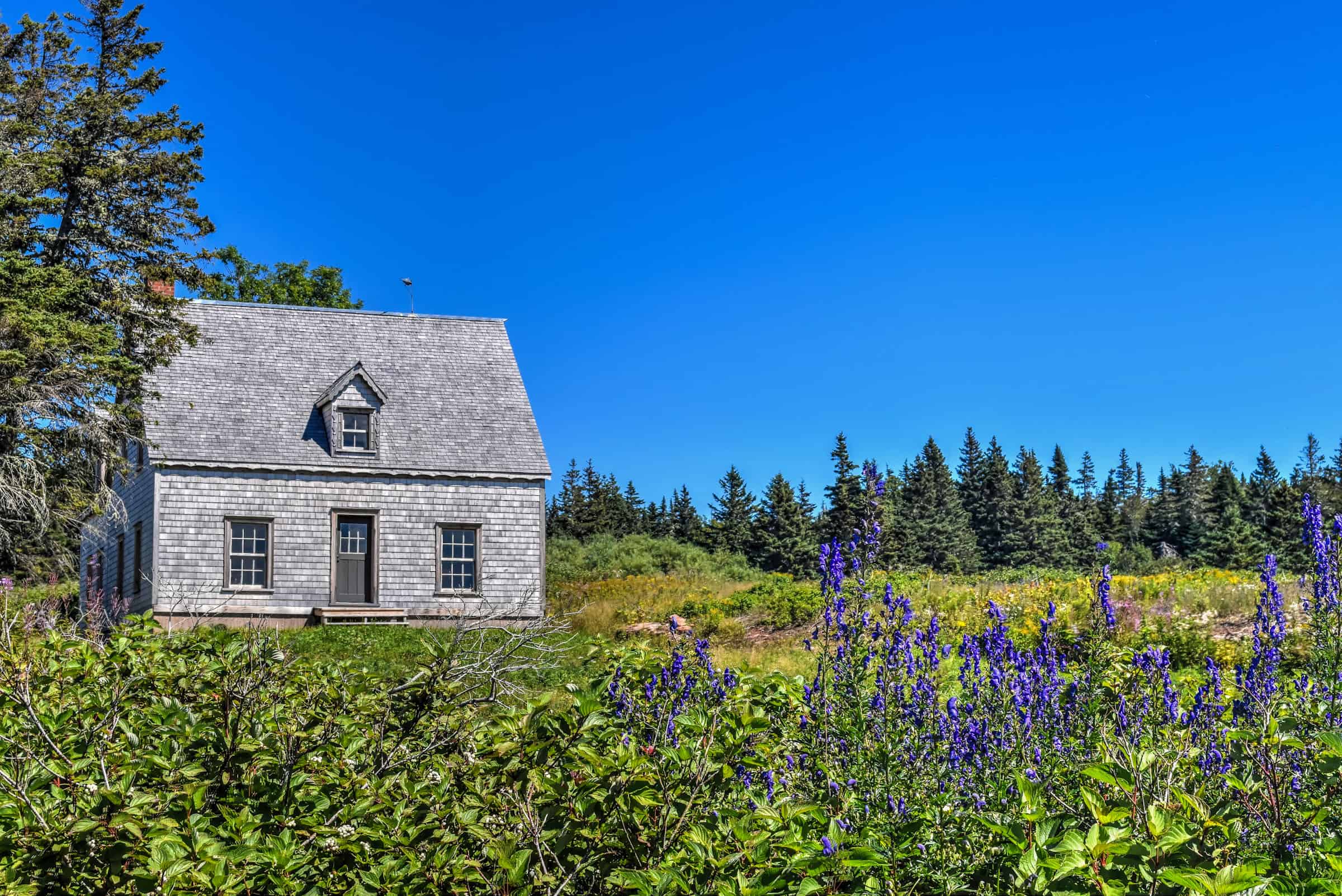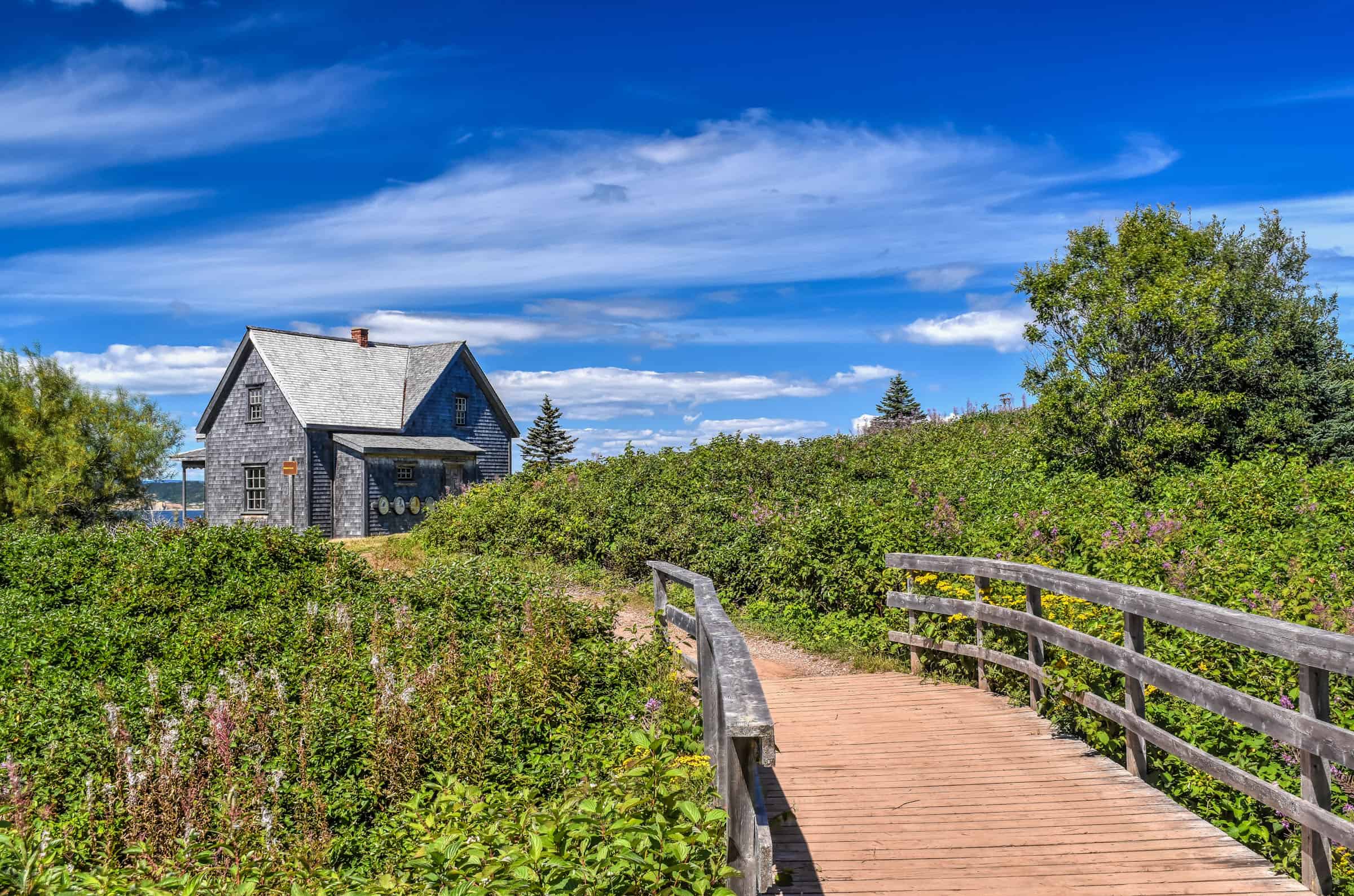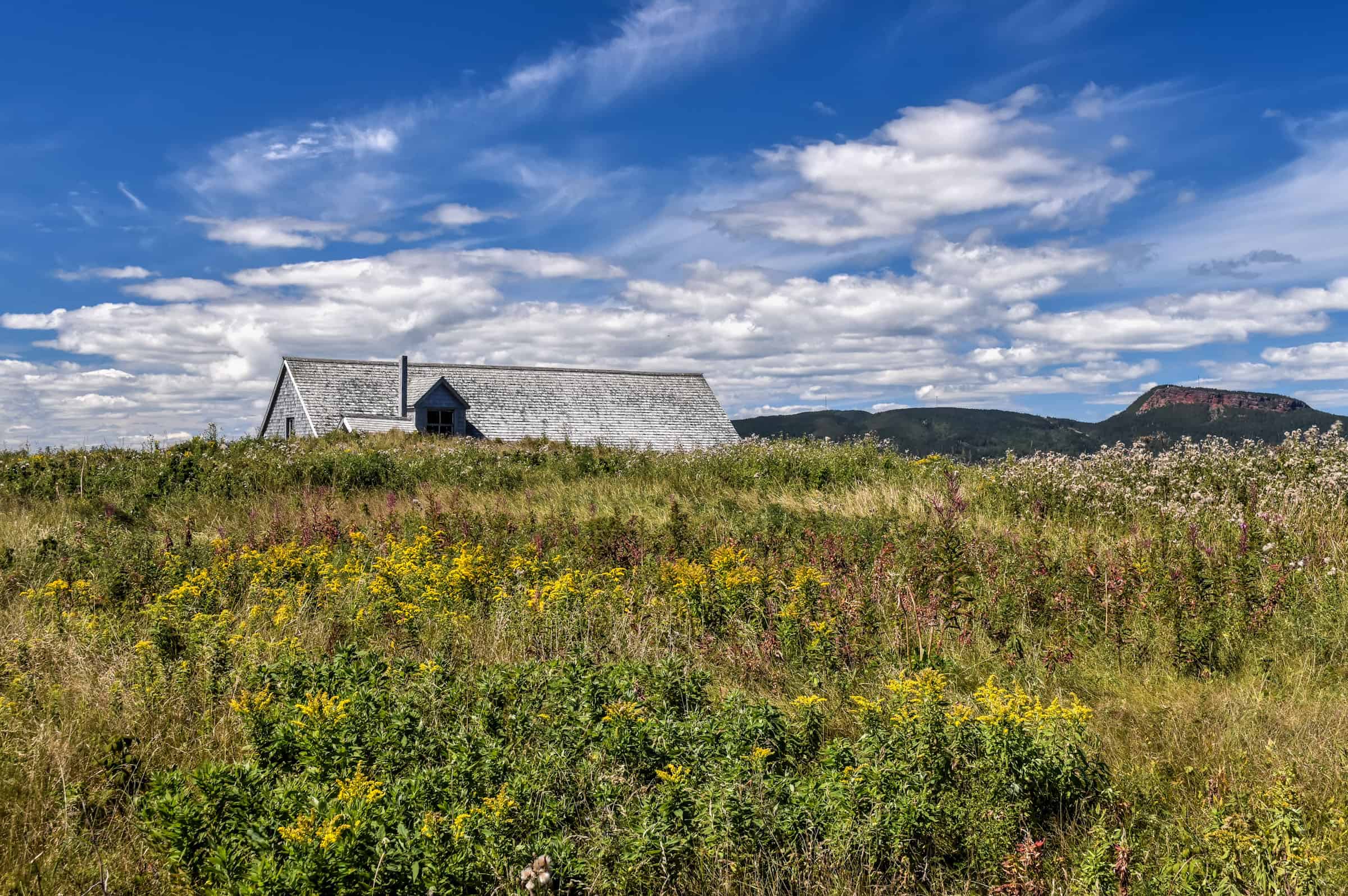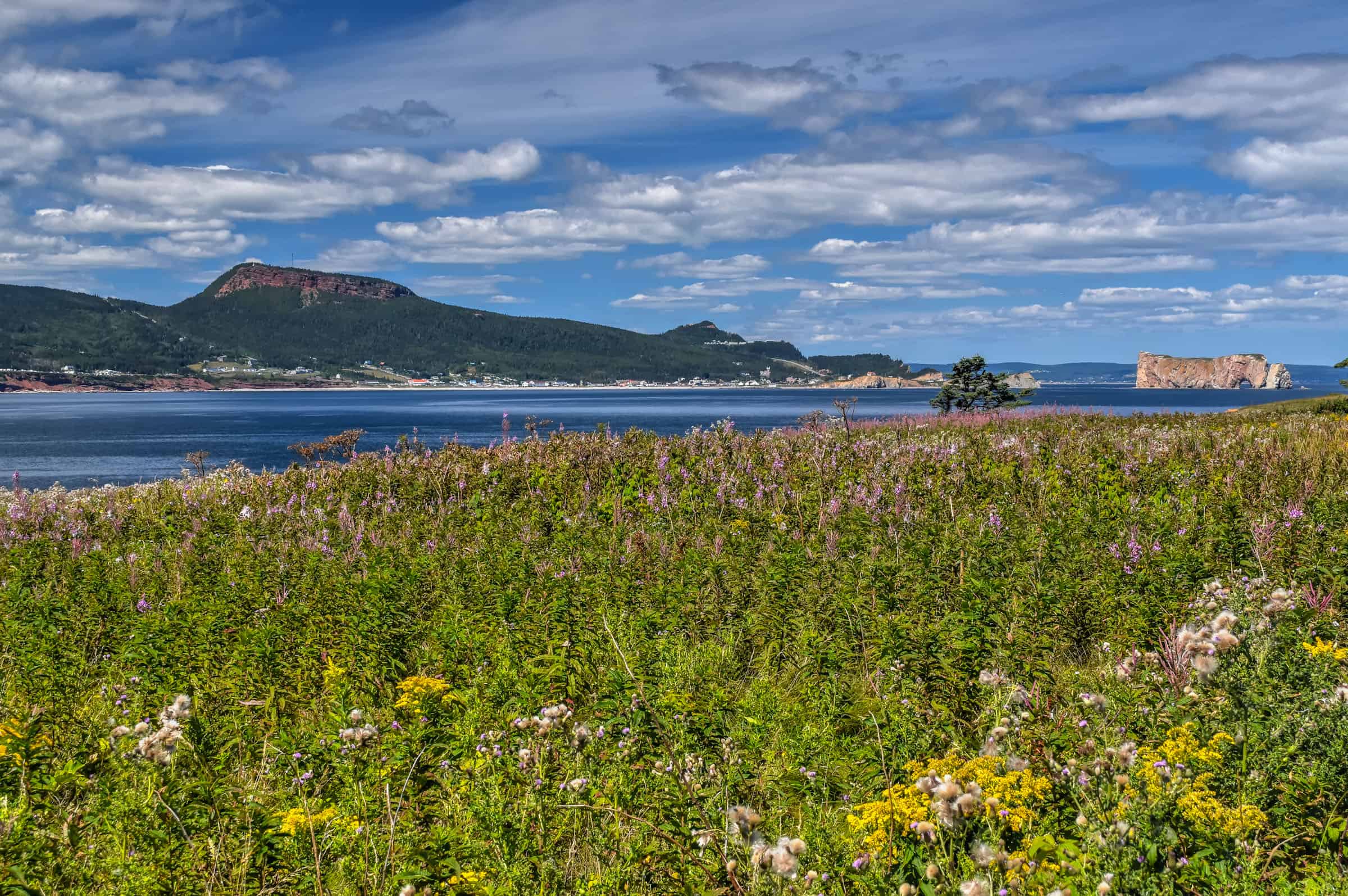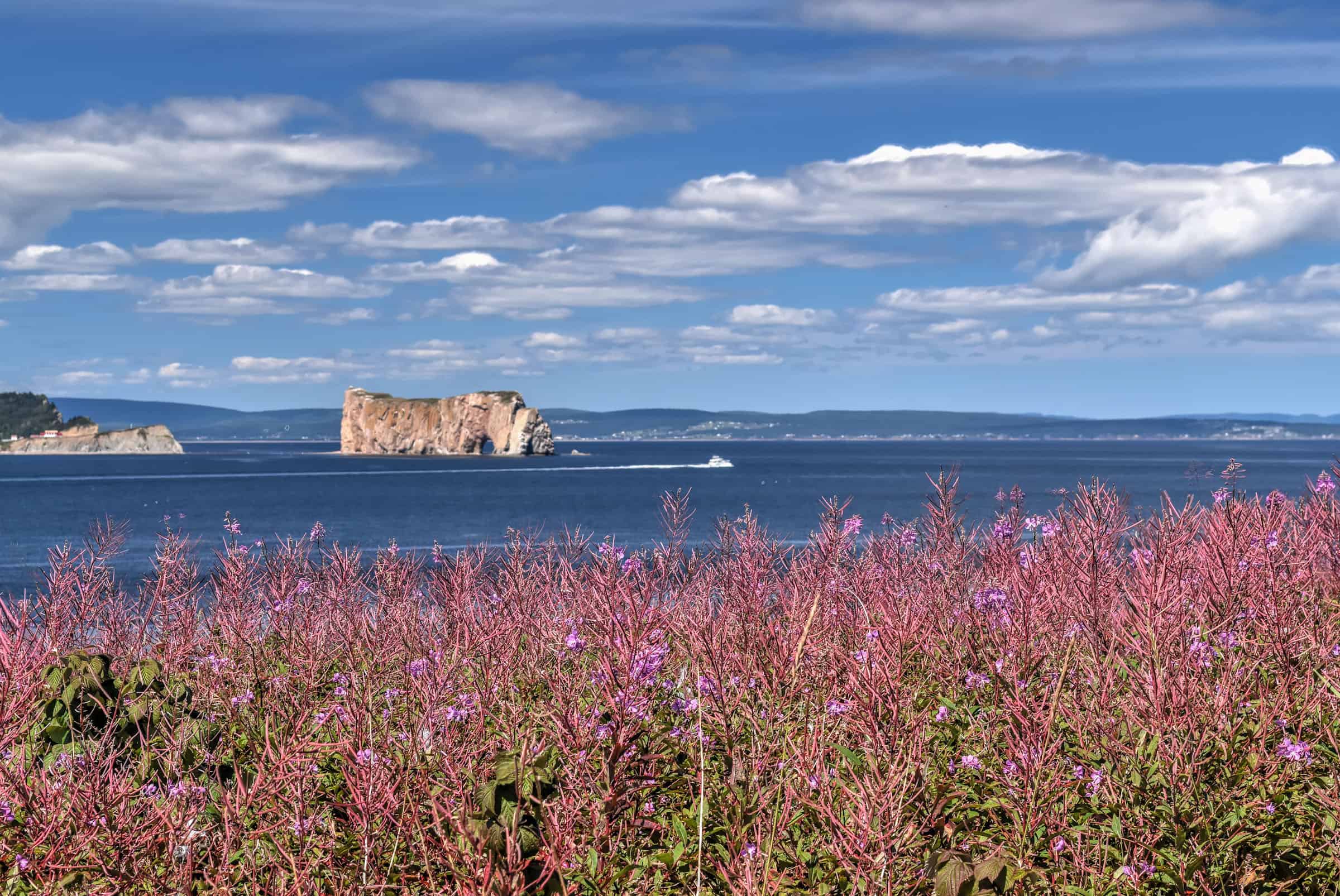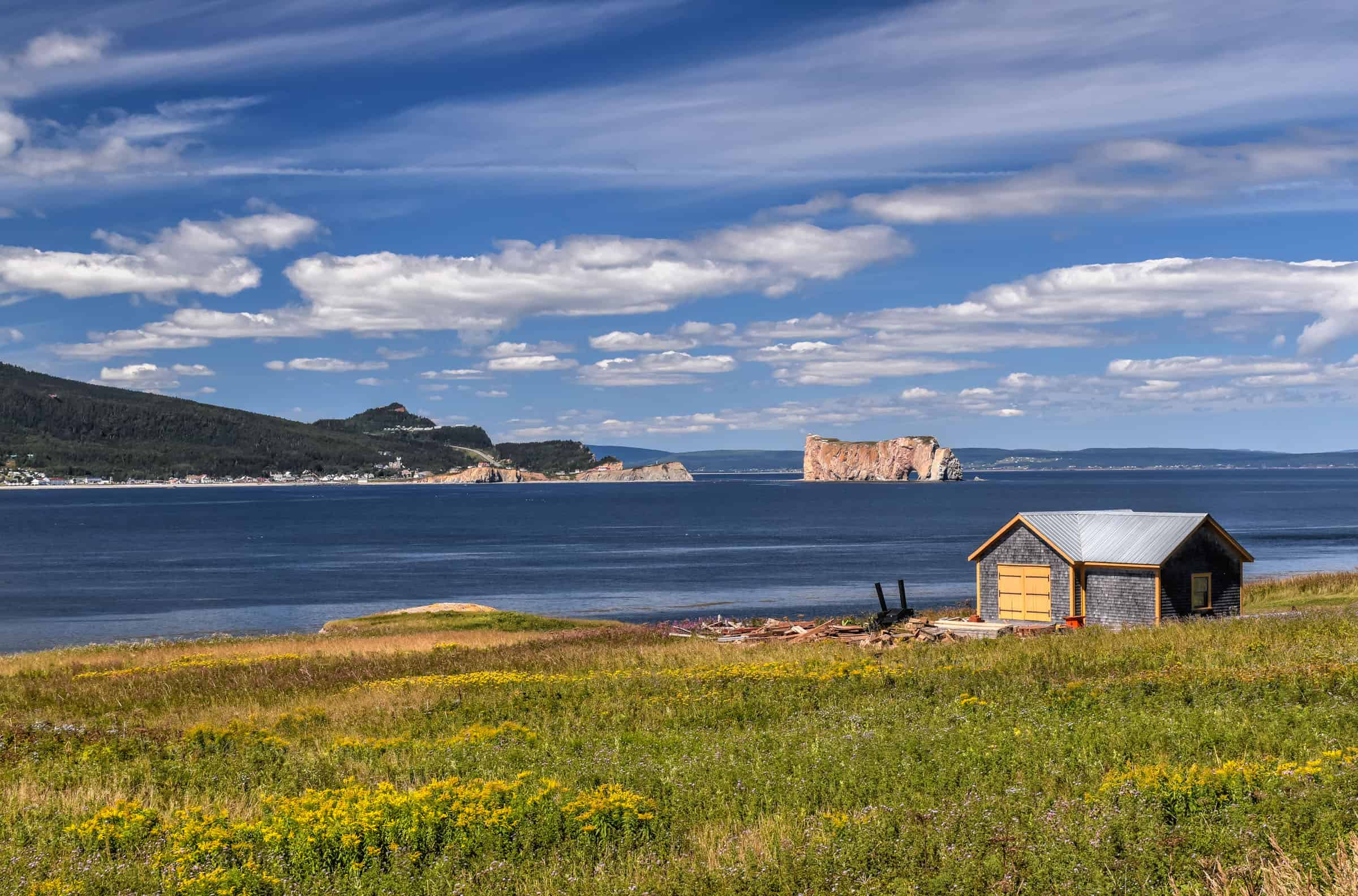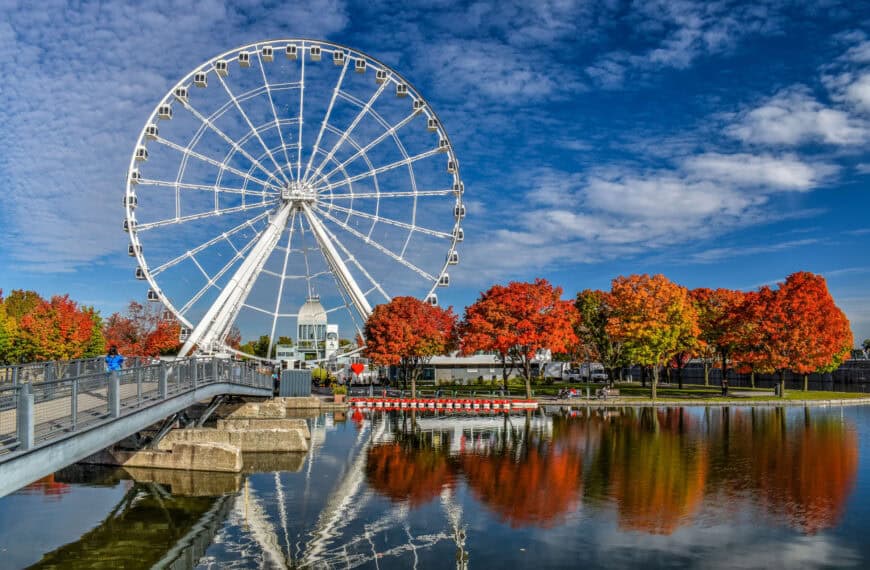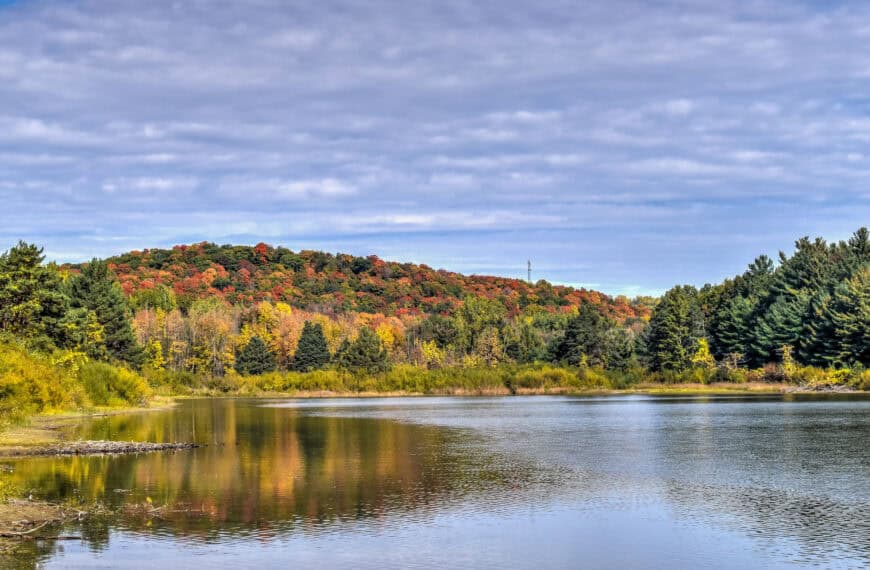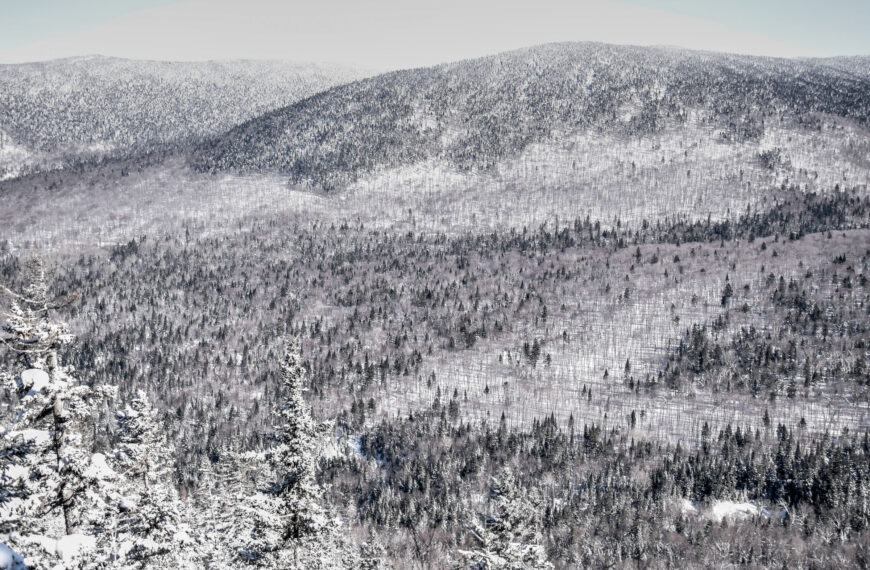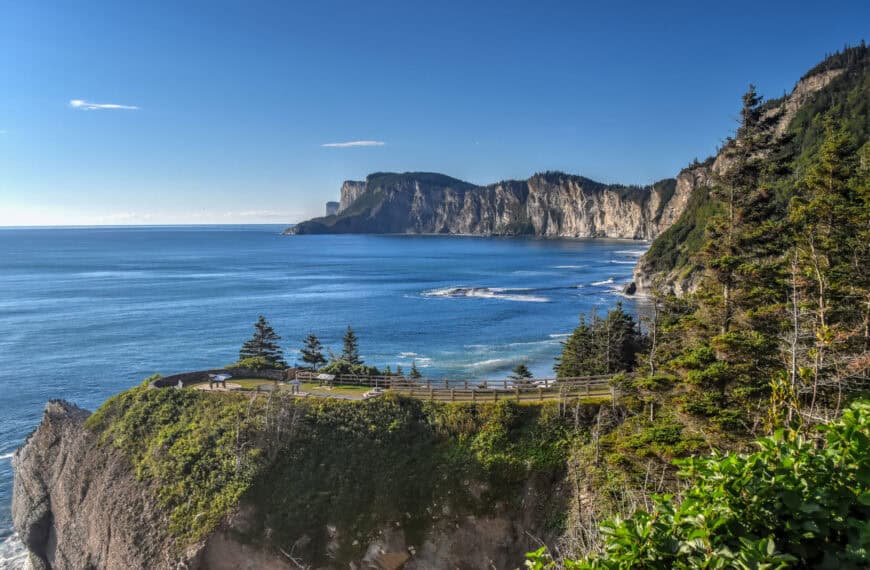No trip to the beautiful Gaspésie region is complete without a visit to Ile-Bonaventure National Park (the park’s full name is Île-Bonaventure-et-du-Rocher-Percé National Park and is often referred to as Bonaventure Island). This spectacular island is located just off the coast of Percé, one of Gaspésie’s touristic centers and known for its famous pierced rock (aka Le Rocher Percé). Although the island is beautiful and scenic in its own right, its main draw is the largest migratory bird refuge in North America, where you will find the most accessible and second-largest Northern Gannet colony in the world. The Northern Gannet is the most common bird found on the island, with a population of over 100,000. For those of you who like walking outdoors, the island also has 4 different hiking trails, all of which connect the port of arrival on the west side of the island to the gannet colony viewing areas along the eastern coast. Below we present our Île-Bonaventure National Park and Northern Gannet Travel Guide, designed to help you get the most out of your visit and admire the unique bird show put on by the northern gannets.
Disclosure: This page (Île-Bonaventure National Park and Northern Gannet Travel Guide) may contain product affiliate links. At no additional cost to you, we may receive a commission for purchases made through these links. More details can be found on our disclosure and policies page.
You might also be interested in these pages:
Gaspésie Best Attractions and Road Trip Itinerary
10 Awesome Hiking Trails to Discover in Gaspésie
Best Things to See and Do Percé
Gaspésie’s Most Beautiful Lighthouses











Orientation – Île-Bonaventure National Park Location
Île-Bonaventure National Park (the blue pin on the map below) is located just off the shores of Percé, Gaspésie. The only way to reach the island is by boat (more on that shortly), but first you have to reach the town of Percé. Both the town of Percé and Bonaventure Island are at the very eastern tip of Gaspésie, which itself is the most eastern point of southern Québec.


Percé is a small town made famous by its large and imposing pierced rock, the natural wonder known as the Rocher Percé. Although it’s a long drive to get to Percé, pretty much from anywhere, the best way to visit and experience Gaspésie is via an awesome road trip along the 132 road, which follows the region’s beautiful coastline.



To get here from Québec City, it’s about an 8-hour drive (750 km) and it’s about a 10h30 drive from Montreal (1000km). There are a lot of great places along the way where you can spend a night (or more) to break up the long drive, and we detail some of these in our Gaspesie Road Trip Itinerary Travel Guide. Some of our favorites include BIC National Park and Gaspésie National Park.
If you need to book a rental vehicle, we highly recommend using Discover Cars to get the best rates on your rental in Montreal.
We also highly recommend Airalo (eSIM card) for your connectivity needs when travelling abroad. Airalo is the world’s first and largest eSIM store with eSIM plans for 200+ countries and regions worldwide.
An alternative way to reach Percé is to take a bus with Orléans Express from either Montreal, Ottawa or Québec City. However, you’ll be limited in your ability to visit the region, which is best explored with your own or rented vehicle. Public transportation options in Gaspésie are limited and infrequent given the region’s low population density.
Three regional airports in Gaspésie have passenger services (Mont-Joli, Gaspé, and Bonaventure). Gaspé Airport (YGP) has direct flights with Québec City, whereas Bonaventure Airport (YVB), which is along the region’s south coast and is unrelated to Bonaventure Island, has direct flights from Montreal. Gaspé, Gaspésie’s largest town with a population of about 15,000, is about a 45-minute drive from Percé. Bonaventure is further away, about a 2-hour drive from Percé.
How to Get to Bonaventure Island?
Bonaventure Island is only accessible by boat. Two private companies offer trips departing from the Percé wharf (by the boardwalk): Les Bateaux de Croisières Julien Cloutier and Les Bateliers de Percé. Tickets are available on-site only from one of the ticket booths in Percé. Note that boat trips do not include admission to the Île-Bonaventure National Park. Both companies charge the same rates ($40 for a direct trip (with return) to the island, or $45 for a trip that includes a close-up of the Rocher Percé) (2024 rates; reduced rates available for children). Both companies also offer whale-watching tours.
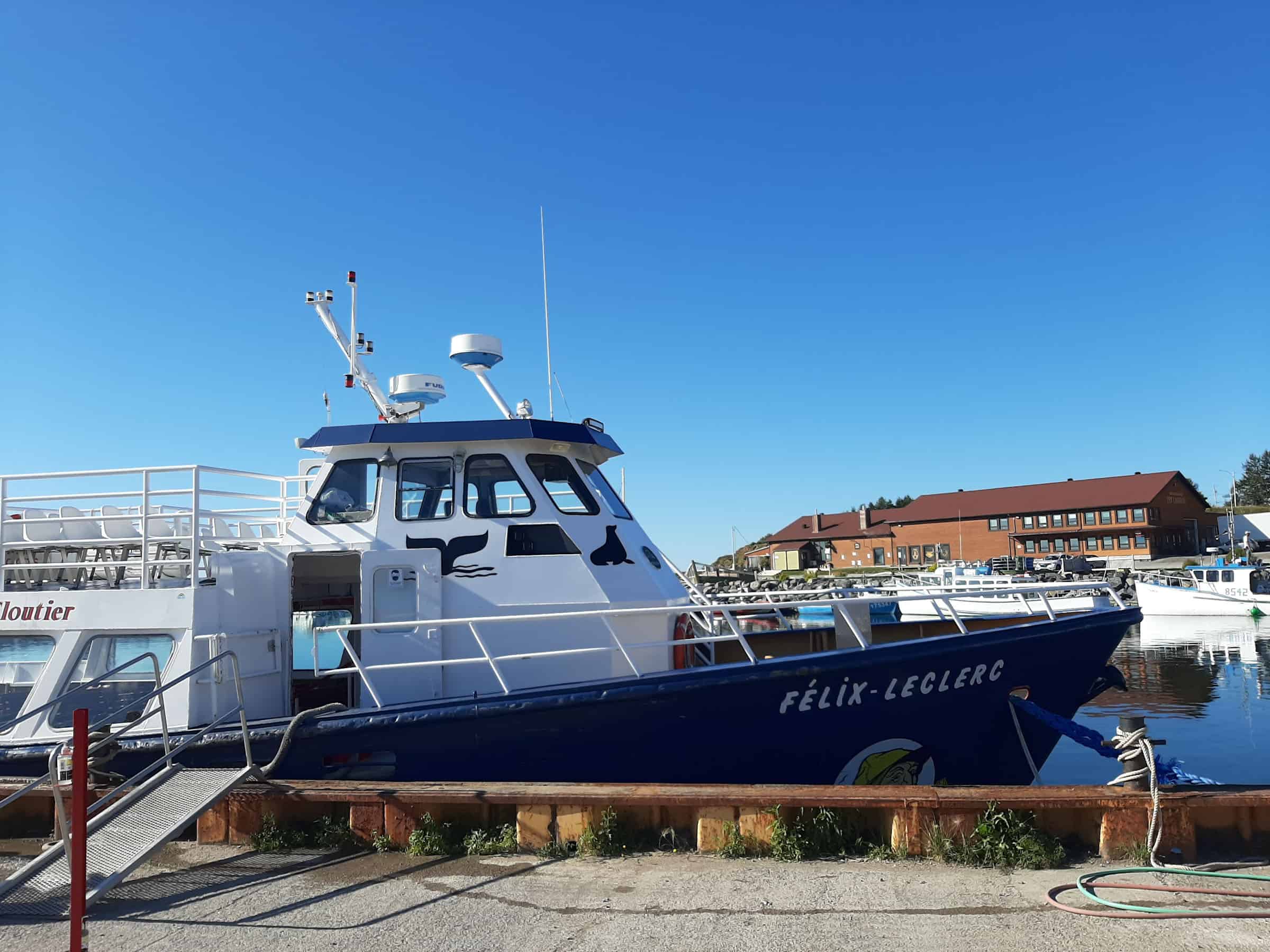
Consult the ferry company websites for up-to-date boat transit schedules, as they change throughout the tourist season (though typically the first departure is around 9 am and the last return trip leaves the island around 4 or 5 pm).

No overnight stays are permitted on Bonaventure Island, and therefore it is mandatory to leave with the last with the last departing boat.
We recommend getting on the very first boat in the morning to the island, if possible, and once you’ve docked head straight to the colony via the Mousses trail. This way you’ll be able to enjoy the colony without the hoards of other tourists that arrive with later arrivals and crowd the colony viewing areas.



Best Time to Visit Île-Bonaventure National Park Location
Boat service to the island only from June 2nd to October 14th (2024). Although the warmest months to visit are July and August, they also tend to be the busiest. We would suggest visiting in late June or late August/early September to benefit from good weather with fewer other tourists. That being said, given the short season when it is permitted to visit the island, there isn’t really a bad time to go.
Ideally, you should plan for a few days in the Percé-Île Bonaventure area, as there is lots to see and do other than to to visit Bonaventure Island and its most famous residents, the northern gannets.
About Île-Bonaventure National Park
The Île-Bonaventure-et-du-Rocher-Percé National Park was created to protect the large migratory bird sanctuary found on Bonaventure Island, as well as nearby Rocher Percé just off the mainland coast.
Historically, Bonaventure Island (Île Bonaventure), along with Percé, was among the early seasonal fishing ports of New France. Discovered in 1534 by Jacques Cartier, the island played an important role in the cod-fishing industry and in the region’s subsequent development. The island became a migratory bird sanctuary in 1919 following the 1916 Migratory Bird Convention between Canada and the United States. The Province of Quebec later on acquired ownership of the entire island by an act of expropriation in 1971, evicting the whole population, which at the time consisted of approximately 35 families. Most of the inhabitants were farmers who used sailboats in the summer and horse-drawn sleds in the winter to reach the mainland. In 1985, the Province of Quebec grouped it with the Rocher Percé into the Parc National de l’île-Bonaventure-et-du-Rocher-Percé National Park.
île-Bonaventure-et-du-Rocher-Percé National Park is one of 28 Quebec National Parks, the majority of which are administered by the Société des établissements de plein air du Québec (SÉPAQ) (Nunavik Parks administer the others). Although all provincial parks in Quebec have used the term “national park” since 2002, there is no connection to the federal national park system, administered by Parks Canada.
All Quebec National Parks charge the same access fees and you can buy an annual pass that allows unlimited access to all parks.
Daily access fees and Annual passes
Quebec National Parks are managed by the SÉPAQ, a government agency that manages all provincial parks and wildlife preserves in Québec.
There is a limit to the number of visitors that can enter any Québec SÉPAQ National Park on any given day. It is therefore strongly recommended that you purchase your daily right of access online before a visit or that you acquire an annual pass.
The daily pass ($9.85 (2024)) can be purchased here up to 30 days before a visit.
The annual pass can be purchased here either for unlimited access to a single national park ($49.25 (2024)) or for unlimited access to all SÉPAQ national parks ($88.50 (2024)). Even if you have an annual pass, we still recommend arriving early in the morning or mid-to-late afternoon to avoid showing up to a filled parking lot.
About the Park’s Northern Gannet Colony
Over 200,000 birds live on Bonaventure Island, with over 100,000 being Northern Gannets that return during the breeding season each year (from April to October). The population of gannets wasn’t always as strong, but when the island became a bird sanctuary in 1919 the population grew quickly. The absence of predators and the abundance of food in the Gulf of St. Lawrence provided a perfect location for the gannets.
It’s hard to imagine the sheer size of the colony having never seen it before. As you near the end of your hike towards the eastern coast (on any of the 4 trails on the island), you begin hearing thousands and thousands of birds in the distance and eventually arrive at the largest seabird colony in North America, and the second-largest colony of Northern Gannets in the world. It’s hard to describe with words and even pictures don’t do the scene justice.



Interestingly, gannets are birds of contrast: they are powerful flyers and divers but clumsy and comical on land, particularly when landing as their short legs and large webbed feet lead to awkward landings and take-offs.
When hunting, the gannets track their prey from above using air currents off the water, flying effortlessly high over the sea. To catch their prey (generally mackerel or herring) they dive straight down into the water while reaching a speed close to 100 kilometres per hour with their black-tipped wings tightly tucked behind them, cleaving through the water’s surface like a torpedo. The blow upon impact is absorbed by a strengthened skull and a protective air cushion under the skin.
Wondering where the largest Northern Gannet Colony is located? It’s located in Bass Rock, Scotland. Although you can see them by boat, you can’t get up close to them on land like you can on Bonaventure Island.
Île-Bonaventure National Park and its Hiking Trails
Île-Bonaventure National Park offers 4 beautiful hiking trails totalling 15 km. They all share the same start point (the boat dock) and endpoint (the colony viewing areas), but the similarities end there. One is a coastal trail, another is a partial coastal trail, and two are inland trails.

When you get off the boat that brings you to Bonaventure Island (on the dock near the Resto des Margaux restaurant on the western coast), National Park staff will check to make sure you paid your access fees and will give you a quick speech about the trail options ahead of you and remind you to respect the environment and the wildlife on the island. You will find most of the gannets along the southern portion of the eastern coast (zone highlighted in yellow below).

We didn’t try either of the two inland trails (Colony Trail, Paget Trail). Although the Colony Trail looks like the most direct, it’s more sinuous than the others and it is the trail with the most elevation gain (130 m; 242 m of cumulative elevation gain). We can highly recommend the route we took: the Les Mousses Trail to reach the gannet colony, and then the Chemin-du-Roy Trail for the return hike back to the boat dock.
You can follow the combined loop trail on AllTrails:
Distance: 8.4 km
Route Type: Loop
Elevation gain: 120 m (cumulative elevation gain: 264 m)
Start point: Boat dock
AllTrails rating: (4.7, 295 ratings (2024))
Duration: Most people complete the full loop in around 2h30-2h45 minutes (excluding the time spent observing the northern gannets)
Access Fees: SEPAQ daily rate
Not an AllTrails member yet? We highly recommend signing up for either their free or paid membership plans. The free plan allows you to find new trails and plan routes but it can only be used while hiking if you have access to mobile data. The paid membership plan (AllTrails+) allows you to download trail maps for offline use and provides live progress updates and off-route notifications.
If you are still uncertain – you should know that the All Trails mobile application was voted the 2023 iPhone App of the Year by Apple.
Les Mousses Trail
This is a beautiful trail that is just over 3 km in length. The trail is initially quite narrow, first through forested sections where you are surrounded by moss- and lichen-covered vegetation all around before eventually reaching the northwestern island cliffs, offering magnificent views of the open sea ahead along with beautiful colored wildflowers.









By now, you don’t quite see the colony, but you can definitely hear them – they are a loud bunch!
The Gannets Viewing Areas
As you approach the colony, the noise can become quite deafening, but you hardly notice or are bothered by it given the stunning visual of the sheer number of birds ahead of you. Surprisingly, the birds seem perfectly indifferent to the presence of visitors, despite how close we can get to them, from behind wooden and rope barriers. It definitely felt like a privilege to be able to get so close to these spectacular birds.



They are beautiful to see glide through the air.





And definitely entertaining to watch land.



The Northern Gannet colony occupies a large space along the island’s eastern coast. The viewing areas stretch over a few hundred meters before the path turns into the Chemin-du-Roy Trail. You can stay as long as you like here, just be sure not to miss the last departing boat.
We probably stayed around 45 minutes, including a short break for a snack (there’s a snack bar and picnic tables near the viewing areas, more on these below).



Chemin-du-Roy Trail
In addition to being a beautiful coastal trail, it is also a heritage trail that reflects the island’s rich historic past. The trail alternates between forests, rocky coastlines and idyllic meadows. You are also very likely to see (and hear!) a pack of grey seals along the island’s southern coast.



Once you reach the beautiful coastal meadows, you will notice completely restored ancestral homes, many of which you can visit along the way.









Bonaventure Island Food options
Relais des Fous
This is a great little snack bar located right beside the Northern Gannet colony, with a large outdoor patio. They offer a wide range of snacks and refreshments.
Resto des Margaulx
For a more hearty meal, head to this restaurant housed in the former warehouse of the LeBoutillier company, right by the boat dock. They offer a healthy menu inspired by the sea, including soups, sandwiches (lobster, smoked salmon), desserts and various cold drinks and local beer options.
Picnic tables
Another great option is just to bring your own snacks and meals as there are many picnic tables around the island. While most of them our found near the restaurant and snack bar, they can be found in a few other places as well.
Hiking Packing List
All Trails subscription – This comes in really handy for areas with little or no cell reception, as the annual subscription allows you to download trail maps for offline use.
External Battery – If you are using your phone to track your progress along the trail or to help with navigation, you certainly don’t want your phone to die on you. That’s especially true in the unlikely event that you might get hurt or need assistance.
Hiking poles – These can be particularly useful in steep trails or muddy/boggy trail conditions.
Water Filter Bottle – The Life Straw bottle is an advanced water bottle with a filter that not only improves water taste but more importantly filters out bacteria and parasites, chemicals and microplastics.
Headlamp – very practical and a smart choice if you plan to start your hike before sunrise or finish it after sunset.
Île-Bonaventure National Park Trail Tips
-Mosquitoes and black flies can be a nuisance at certain times during the year. The exact dates vary from year to year, but they are generally most present from mid-May to mid-July. Regardless of when you come, it’s always a good idea to carry some bug spray with you, just in case.
-Stick to the designated path to protect the surrounding environment.
Planning a trip to Gaspésie?
You might be interested in these pages (coming soon):
Gaspésie Best Attractions and Road Trip Itinerary
10 Awesome Hiking Trails to Discover in Gaspésie
Gaspésie’s Most Beautiful Lighthouses
We also highly recommend these guidebooks:
Lonely Planet Best Road Trips Ontario & Quebec
Gaspé the Romantique ‘Revisited’: A Road Trip Guide to the History, Legends and Attractions
Want to Discover More Quebec Hiking Trails?
You might be interested in these pages (coming soon):
Best National Parks for Hiking Near Montreal
Best Hiking Trails in the Laurentians
Best Hiking Trails in the Eastern Townships
Photography Gear
If you like our photography, you might be interested in some of the gear we use to shoot our travel and hiking destinations.
Camera Body – Nikon Z 6ii Fx-series Mirrorless Body
Main Lens – NIKON 24-120mm F/4G ED VR AF-S
Zoom Lens – Sigma 745-306 150-600mm f/5-6.3
Polarizing filters – Urth Circular Polarizing (CPL)
Camera Tripod – K&F Concept 64-inch Camera Tripod
Mini-tripod – Lammcou Flexible Camera Tripod
Camera/hiking backpack – Vanguard Alta Rise 48 Backpack
Universal Travel Adapter – VYLEE Universal International Power Travel Plug
Other Travel Essentials
Travel Insurance
SafetyWing is a travel insurance company that offers comprehensive coverage for travellers. Includes Medical Insurance and Travel Insurance. Primarily geared towards long-term travellers, digital nomads, and expats.
e-Sim cards
Airalo is the world’s first and largest eSIM store with eSIM plans for 200+ countries and regions worldwide. With Airalo eSIMs, travellers can get connected the moment they land at their destination and avoid nasty data roaming charges
eSIMS are a sustainable alternative to single-use SIM cards – they are 100% digital, require less energy to produce and be re-used rather than disposed of.
Car Rentals
Discover Cars is our go-to website for car rentals. We almost always find our preferred rate there.
Transfer from Airport
Welcome Pickups is our favourite private transfer service, which you can pre-book at a fixed price. Currently available in 220 cities all over the world (mostly in Europe, but with several major cities in Asia, the Middle East and the US).
Kiwitaxi is another private transfer service – we haven’t tried it yet, but it’s currently available in a few more countries (102 as of 2024).
Hotels and Accommodations (coming soon)
Photography Prints
If you found this blog useful, you can help support our blog by purchasing low-cost digital prints. Printed physical prints are also available for purchase.








—–
Well, that wraps it up! We hope you enjoyed our Guide to the Île-Bonaventure National Park and Northern Gannet Travel Guide and that it will prove useful for planning your hiking trip.
—–
You might also be interested in these related pages:
